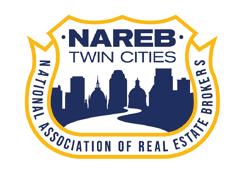




The ACLU doesn’t endorse or oppose candidates for elected office, but we recognize that the 2024 presidential election has immense implications for the future of our democracy. In 2022, the Heritage Foundation, a conservative-leaning think tank, and 140 former Trump
staffers put together Project 2025
— a roadmap for how to replace the rule of law with right-wing ideals.
What is Project 2025?
Project 2025 is a federal policy agenda and blueprint for a radical restructuring of the executive branch authored and published by former Trump administration
officials in partnership with The Heritage Foundation, a longstanding conservative think tank that opposes abortion and reproductive rights, LGBTQ rights, immigrants’ rights, and racial equity. Project 2025’s largest publication, “Mandate For Leadership,” is a 900-page manual for reorganizing the entire federal government agency by agency to serve a conservative agenda.
Project 2025 includes a long list of extreme policy
recommendations touching on nearly every aspect of American life, from immigration and abortion rights, to free speech and racial justice. A number of its recommendations rely on support from the executive branch and from Congress. Many other initiatives are outright unconstitutional.
What Are Some Plans/Proposals Included in Project 2025?
Project 2025 calls for hundreds of individual policy changes that will impact our constitutional freedoms, and every aspect of our lives. Among them are:
GUTTING ABORTION ACCESS
Severely limiting abortion access nationwide by reversing the FDA’s approval of mifepristone, a drug used in medication abortion, and reviving a 19th century law, the Comstock Act, to ban any abortion medications, equipment, or materials from being sent through the U.S. Postal Service.
MASS DEPORTATIONS
Targeting immigrant communities through mass deportations and raids, ending birthright citizenship, separating families, and dismantling our nation’s asylum system.
ABUSING WARRANTLESS SURVEILLANCE
Exploiting the executive branch’s vast and unprecedented powers to spy on Americans’ lives with warrantless surveillance of our data.
UNLEASHING UNDUE FORCE ON PROTESTORS
Violating the First Amendment by using federal law enforcement to target journalists and protestors.
SEVERELY LIMITING VOTING ACCESS
Abusing executive power to interfere in our elections by criminalizing the voting process and damaging fair representation.
CENSORING CRITICAL
DISCUSSIONS IN CLASSROOMS
Censoring academic discussions about race, gender, and systemic oppression, in violation of the First Amendment, and promising to cut federal funding for schools with curricula that touch on these subjects.
ROLLING BACK TRANS RIGHTS
Weaponizing federal law to require states and private actors to discriminate against transgender people by threatening to sue schools that protect the rights of trans students or telling hospitals that they would lose their Medicaid funding if they provide gender-affirming medical care to trans adolescents.
What Are Donald Trump’s Connections to Project 2025?
Project 2025 was published by The Heritage Foundation, a longstanding conservative think tank with direct ties to former President Trump’s administration. Though Trump has falsely claimed he is not connected
to Project 2025, a recent report from CNN found at least 140 people who worked on Project 2025 previously worked in the Trump administration. The Heritage Foundation President Kevin Roberts also previously worked on President Trump’s transition team in 2016, and has described his organization’s role as “institutionalizing Trumpism.” Roberts was also one of the principle advocates for overturning the 2020 election to keep Donald Trump in office after he lost the election. Heritage Foundation executive Mike Howell recently called the 2024 election illegitimate before voting even began, claiming without evidence that any result other than a Trump victory will have been the result of fraud.
ACLU fights back In a series of 13 memos, the ACLU details the civil liberties and civil rights challenges presented by a potential Donald Trump or Kamala Harris presidency, and provides a roadmap for how we will fight to preserve and expand
aclu.org/project-2025-explained
the freedom of all people. This includes: Going to court to preserve and advance the rights of immigrants, LGBTQ rights, abortion access, nondiscrimination laws, voting rights, and the free speech of all people.
Working with Congress members to enact policy solutions to many of the most extreme proposals in Project 2025 and using Congress’s constitutional powers to provide oversight, investigate wrongdoing, and defund executive branch policies which restrict our fundamental freedoms.
Working with state lawmakers around the country to enact proactive laws that protect people from federal interference. Organizing in communities to educate the
By Pulane Choane
Writer
Prominent faith leaders gathered on The Conversation with Al McFarlane livestreamlast week to address the complexities of political engagement, voter mobilization, and the challenge of misinformation ahead of the November 5th election. The discussion, held just days before the Black Men’s Legacy Summit III on October 26, highlighted the essential role of the Black church in Minnesota’s political landscape and the need for sustained civic involvement.
This upcoming election holds significant weight not only for Minnesota but for the nation at large. With key races ranging from local government to national leadership, the stakes are high, particularly for communities of color. Issues such as voter suppression, disinformation, and political apathy are real threats to democratic participation, especially in Black communities that have historically faced barriers to voting. For Minnesota, where political outcomes can often influence broader national
trends, this election is pivotal in determining policies on economic equity, criminal justice reform, healthcare, and education—issues disproportionately affecting Black and marginalized communities. Al McFarlane opened the conversation by emphasizing these stakes. “This election carries the weight of history,” McFarlane remarked, setting the stage for a candid discussion about faith, democracy, and political power. Reverend Alfred Babington Johnson, (Babington) a leading voice in the conversation, underscored the historical struggle for Black voting rights, from being counted as threefifths of a person to securing the right to vote through the 15th Amendment. “We cannot forget that our right to vote was hard-fought and hard-won,” Babington reminded listeners. Babington explained that His Works United, a coalition of African American churches, has been working tirelessly to mobilize voters through initiatives such as Souls to the Polls. “We’re not just getting people to vote—we’re engaging them in the process of building their future,” he said,
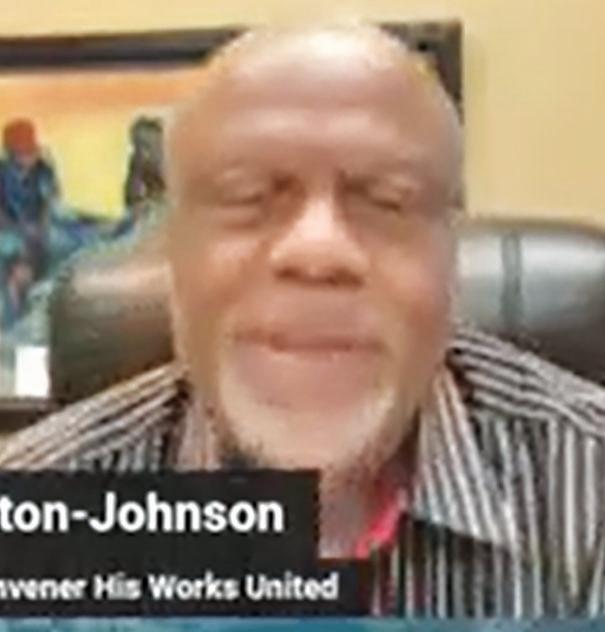
emphasizing that the church continues to play a critical role in shaping political engagement within the community, much like it did during the Civil Rights movement. However, the conversation quickly turned to the rising influence of Christian nationalism and how faith is being manipulated for political gain. Reverend Melvin Miller raised concerns about the narrative portraying former President Donald Trump as a divinely chosen leader, a theme that has gained traction within some religious circles. “It’s astonishing how these ideas block meaningful discussion,” Miller said. “We can’t talk about real issues like the economy or
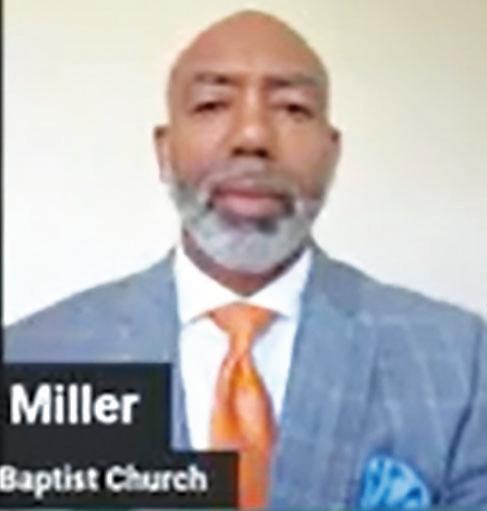
Kamala Harris’s leadership if people are stuck on the idea that Trump is ‘God’s anointed.’” Reverend Elijah McDavid explored how white evangelical ideology has increasingly shaped political decisions in Black church spaces. “We’re seeing people base their votes narrowly on issues like abortion or LGBTQ+ rights,” McDavid explained. “But what about biblical values that call us to welcome immigrants, share wealth, or care for the environment?” He stressed the need for broader discussions that reflect the full scope of Christian values, not just those promoted by partisan agendas. The rise of Christian nationalism threatens to narrow
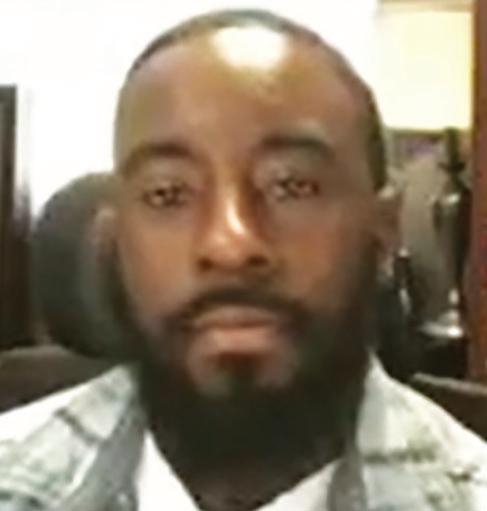
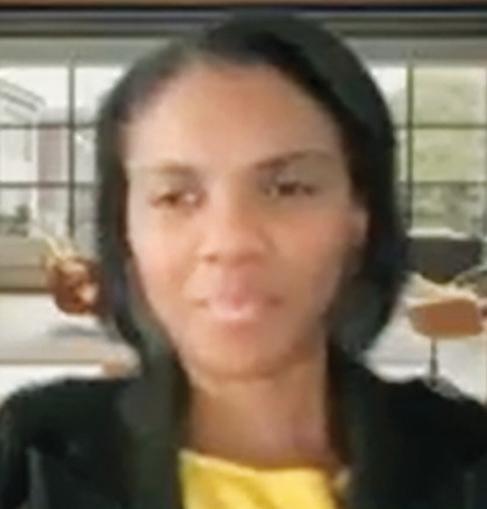
the focus of moral and ethical decision-making, a concern that resonated throughout the panel. McDavid also cautioned against dismissing those in the community who feel disillusioned with traditional political parties. “Shaming people won’t help,” he warned. “We need to understand their frustrations and engage with empathy.” This sentiment captured the complex reality facing Black voters, who often feel let down by both major political parties. The panel agreed that engaging voters goes beyond election cycles. “We can’t wait until the last minute,” emphasized Shemeka Bogan, founder of the Strong Roots Foundation. “Civic engagement has to be a year-round effort.” Bogan explained that initiatives like Souls to the Polls encourage deeper community involvement by combining faith-based efforts with practical support, such as transportation to voting sites. With early voting Sundays and block parties planned throughout Minneapolis and St. Paul, the effort to energize voters is well underway. “It’s not just about voting,” Bogan added. “It’s about reclaiming our power and ensuring that our communities are represented.”
By Stacy Brown, Sr. and Greer Marshall
With just one week until the pulse of the nation beats at the ballot box and over 51 million votes already cast, Kamala Harris stood before an audience Tuesday night that outgrew its bounds. What was once imagined as an intimate gathering of 8,000 souls evolved into an ocean of hope, a swelling tide of support that illuminated the final stretch of her journey, with over 75,000 people gathering at the Ellipse in our nation’s capital.
At 7:37 pm, under a sky heavy with purpose, Harris stepped onto the stage, embraced by a wave of thunderous love—a scene lit in flashing reds and blues, where applause rolled like a breaking tide. Her spirit was ablaze as she lifted her voice: “Good evening, America!” Each word rose above the chants of her name, pulsing through the crowd, “Kamala, Kamala.”
Her gaze remained steady and with reverence for each life present as she continued to speak. “Thank you for taking the time out of your busy lives.”
When she paused, it was clear that she was feeling the weight of the moment. With clear conviction, she said, ”One week from today, you will have a chance to make a decision that directly affects your lives, the lives of your family, and the future of this country. It will probably be the most important vote you’ve ever cast,” she said. Beyond selecting between two parties and two candidates, she said, “It’s about more than just making a choice—of whether you have a country of freedom or one ruled by division.”
Emphasizing her focus on “common ground and common-sense solutions,” Harris promised to hold space for all, regardless of creed or corner of the country. “I am
not here to play politics; I am here to make progress,” she proclaimed, as “Freedom” and “USA” banners waved above the crowd like living symbols. “Unlike Donald Trump, I don’t believe people who disagree with me are the enemy. He wants to put them in jail. We have to stop pointing fingers and start locking arms. It’s time to turn the page on the drama, conflict, fear, and division,” Harris advises.
The atmosphere was pulsating, like a never-ending fiesta for the soul. To secure her spot, Fatimah Glasnow came five hours early from Southeast D.C. and said she was deeply moved. “The feeling here is hope, love, and peace,” Glasnow said. “An America where we can all thrive, regardless of our race or gender. I needed this kind of energy in my life.” Glasnow felt seen and empowered, and her faith was renewed by Harris’ words, especially on issues of social and maternal justice. “She’s advocated for social justice and, really, justice itself.”
When addressing the fall of Roe v. Wade, her resolve was clear. She promised America, “I will fight to restore what Donald Trump and his hand-selected Supreme Court justices took away from the women of America.” With this pledge, Harris reaffirmed her steadfast commitment to preserving and expanding civil rights.
Capitol Hill resident Leander Davis, a social services worker, said Harris’ words resonated deeply. “She’s all of us,” Davis said. “She’s been criticized, ostracized, demonized, and called all sorts of names, yet she hasn’t stopped fighting for what’s right. When she’s president, we will all be better off.”
Harris’ campaign is woven from a life spent challenging injustice and protecting those vulnerable. This was personal. As her words
echoed, the crowd’s response was nothing less than electric. Harris made it clear: Her campaign was a call to action. Vowing, “If you give me the chance to fight on your behalf, there is nothing in the world that will stand in my way.”
A striking contrast to the divisive language that has marked Trump’s racist rhetoric, Harris did not shy away from the comparison. “If elected, Donald Trump would walk into that office,” Harris said, gesturing toward the White House, “with an enemies list. When elected, I will walk in with a to-do list.” Her words painted a vision of governance rooted not in vengeance but in purpose. Her administration, she pledged, would focus on practical solutions: lowering costs, supporting working families, and rekindling a sense of unity and shared ambition across the nation.
Though her years as Vice President under President Joe Biden had been an honor, Harris acknowledged the urgency of a new direction. “I have been honored to serve as Joe Biden’s vice president,” she said. “But I will bring my own experiences and ideas to the Oval Office. My presidency will be different because the challenges we face are different.” Her voice conveyed both respect and determination—a promise to carry forward Biden’s legacy but forge a new path to meet America’s evolving needs.
The vice president confronted the charged topic of immigration, calling for accountability and cooperation.
“Politicians have got to stop treating immigration as an issue to scare up votes in an election— and instead treat it as the serious challenge that it is,” she said, “that we must finally come together to solve.” She also insisted that “I will work with Democrats and Republicans to sign into law the border security bill that Donald Trump killed.” Harris said while
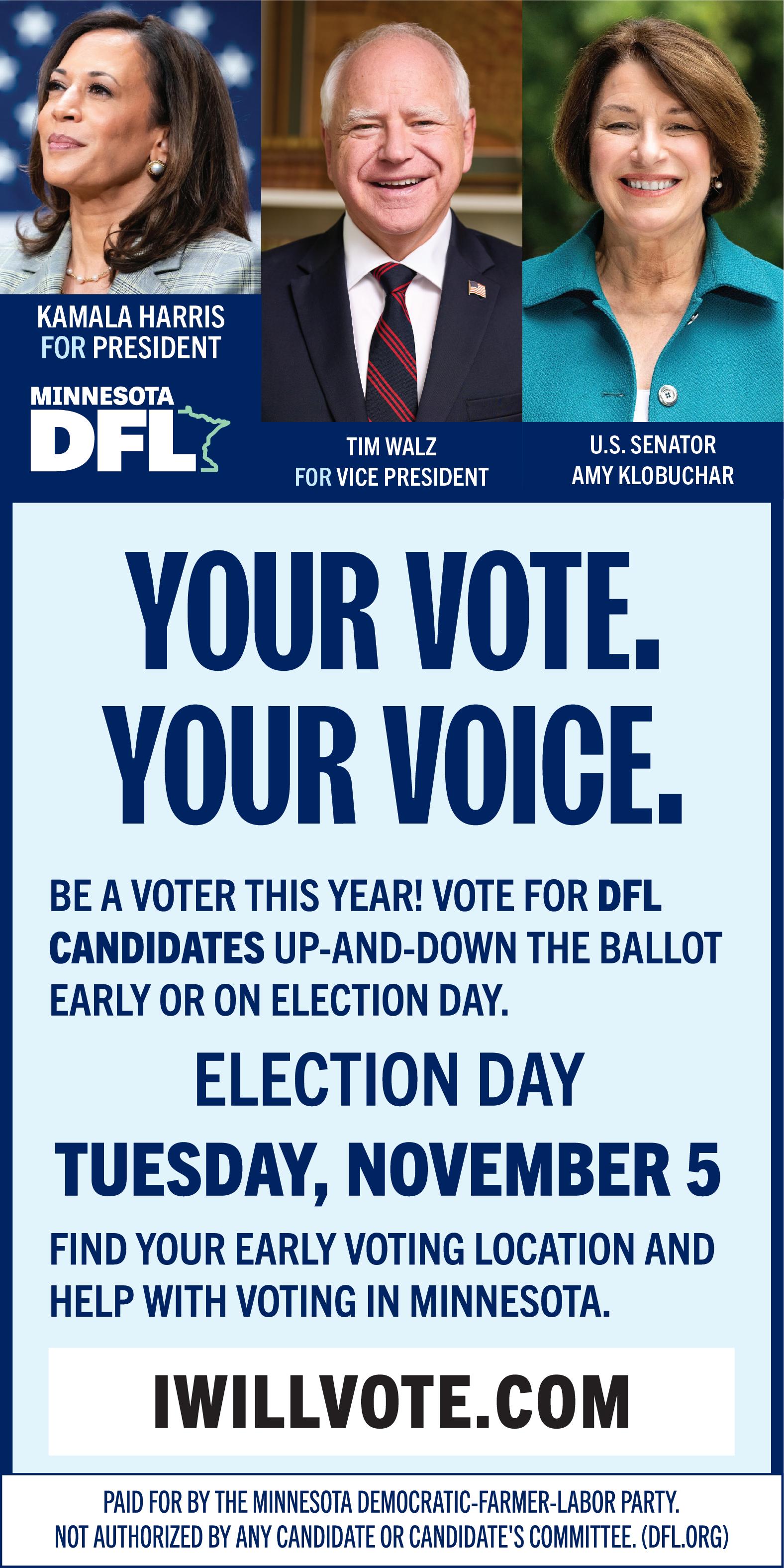
she will focus on prosecuting cartels and transnational gangs, “we must acknowledge we are a nation of immigrants.” Vowing to push for change that would reflect the country’s roots and values. Harris said, “And I will work with Congress to pass immigration reform, including an earned path to citizenship for hardworking immigrants, like farmworkers and our laborers.”
As her speech reached its crescendo, Harris delivered a final rallying cry. “America, we’ve been consumed by division, chaos, and mistrust for too long. But it doesn’t have to be this way,” she proclaimed, her voice rising with passion. “It is time for a new generation of leadership, and I am ready to offer that leadership as the next President of the United States.”
Evoking images of marches and a vision of unity, she said, “I grew up as a child of the civil rights movement.” She said, “My parents took me to those marches, pushing me in a stroller through crowds of people of all races, faiths, and walks of life, all fighting for the ideals of freedom and opportunity. I’ve lived the promise of America.”
Her voice was thick with memory and gratitude as

she reflected on her mother’s sacrifices and determination, sharing, “I saw how hard our mother worked to give her daughters the same chances this country gave her,” Harris said. “Growing up, I was blessed to have family by blood and family by love, who instilled in me the values of community, compassion, and faith that have always defined our nation at its best. I’ve lived the promise of America.” In her closing remarks, her face reflected the nation’s hopes and struggles. “I’ve spent my life fighting for the people who have been hurt and counted out, but never stopped believing that in our country anything is possible,” Harris said. “I have lived the promise of America, and I see the promise of America in all of you. In all of you, I see it.” Harris’
**VP Harris' Zodiac sign (Oct. 20)
6. *Algeria/Egypt/Nigeria (Afr. Union trio (initials)
7. *'40 __ and a mule' (failed promise made to 4 million freed slaves (1865)
8. Democrats convention city locale, 2024 (abbr.)
9. One adding things up
12. **VP Harris' alma mater (HBCU, 1986)
15. "The Catcher in the ___"
17. *Activist Davis' monogram
20. **Kamala's insight, so to speak
21. **KH's accolades, for example
25. **Theme of this puzzle
27. *Black Wall Street massacre locale (1921)
28. Health resort
29. **VP Harris' chief, informally
30. Shoe size
35. Abbr. for Kansas State Engineer
36. Turmoil (U_ _ _ ST)
38. Plus (B _ _ _ S)
39. **KH's Christian denomination (abbr.)
42. *_AIL _EVERS: Olympics track champion (1992, 1996)


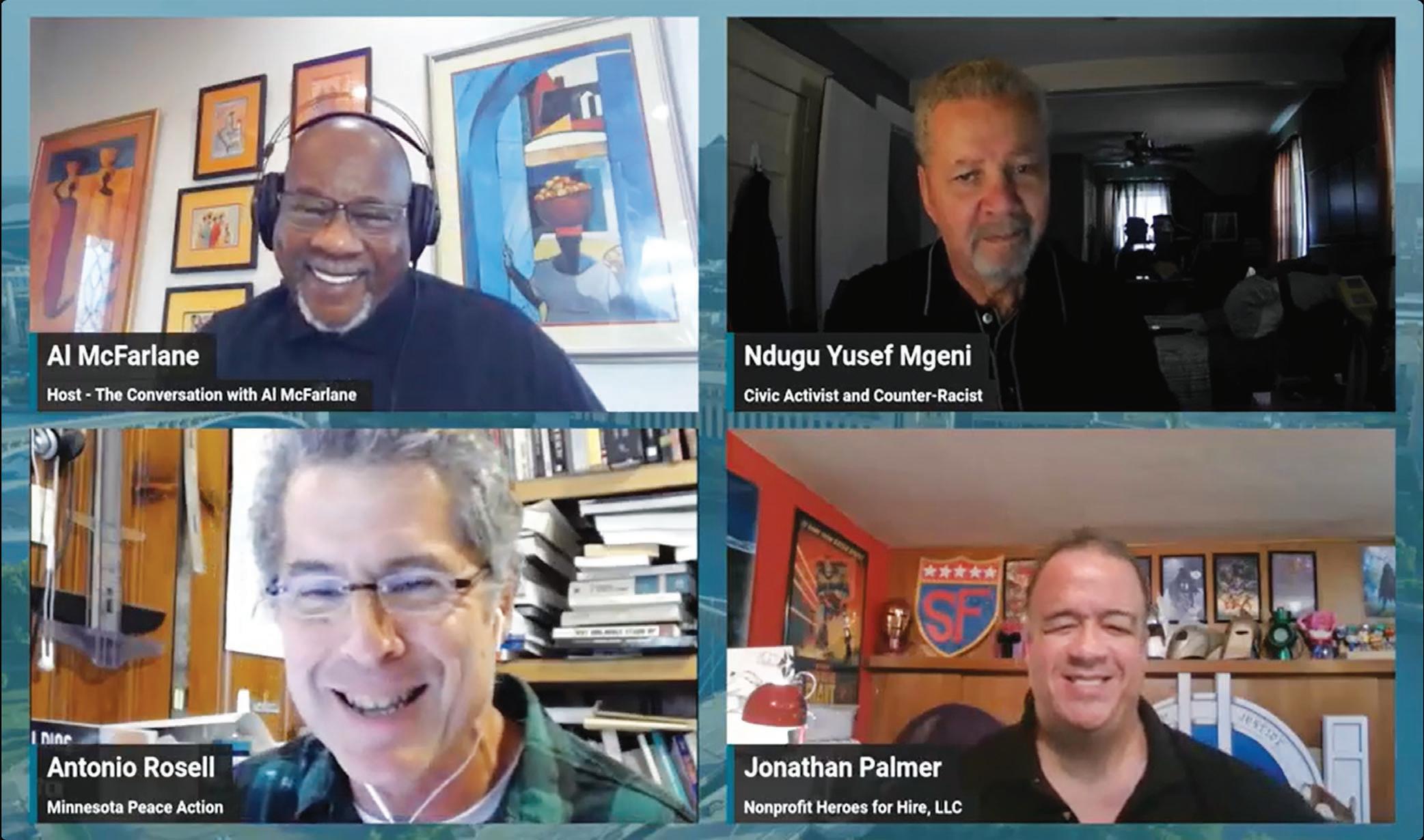
By Pulane Choane Contributing Writer
On KFAI 90.3FM’sThe Conversation with Al McFarlane, a panel of community leaders engaged in a raw and thought-provoking discussion that reflected both the urgency and complexity of the 2024 U.S. presidential election. With just weeks remaining until election day, the conversation weaved between concerns over voter apathy, the erosion of trust
By Pulane Choane Contributing Writer
As the conversation deepened on The Conversation with Al McFarlane, the panel explored the threats posed by disinformation and the role of artificial intelligence (AI) in shaping voter behavior, highlighting how these issues could undermine the upcoming election. Reverend Dr. Charles Gill emphasized the dangers of manipulated narratives designed to confuse and divide. “Disinformation campaigns aren’t just local— they’re international,” Gill warned. “We’re seeing AI tools being used to create false images and manipulate public perception.” This
in political systems, and the role of U.S. foreign policy in driving disillusionment among voters. Host Al McFarlane was joined by Ndugu Yusef Mgeni, an educator, Jonathan Palmer, the former head of the Hallie Q. Brown Center; and Antonio Rosell, a peace advocate and engineer. The discussion revealed the intricate web of anxieties Minnesotans face as they try to navigate a polarized election season against the backdrop of foreign conflicts and systemic voter suppression.
concern comes at a time when AI and social media platforms have become major players in spreading misinformation, particularly targeting communities of color. Disinformation not only distorts facts but also seeks to disenfranchise voters by making them question the integrity of the election process itself. With Minnesota being a battleground state where voter turnout can make or break close races, the issue is particularly pressing. McFarlane echoed these concerns, noting the potential for such tactics to reignite old power dynamics. “Some factions seem determined to revive a mindset that sees us as less than human,” McFarlane
Election Uncertainty Mirrors
2016’s Razor-Thin Margins The conversation opened with Mgeni highlighting how Kamala Harris and Donald Trump are neck-and-neck in key battleground states like Michigan, Pennsylvania, and Wisconsin. “We’re in a dead heat,” Mgeni noted. “The lead Harris built after Biden’s endorsement has evaporated. People feel déjà vu from 2016 when polls favored Hillary, but the outcome surprised everyone.” He expressed
concern about the growing support Trump enjoys from Black and Latino men, whose numbers have doubled since 2016. “That shift is a wake-up call,” he added. “We need to ask why these voters are turning to Trump.” Palmer picked up on this theme, cautioning against focusing solely on polls. “It’s not just about Harris versus Trump,” he said. “The election is about down-ballot races too. Legislative control is on the
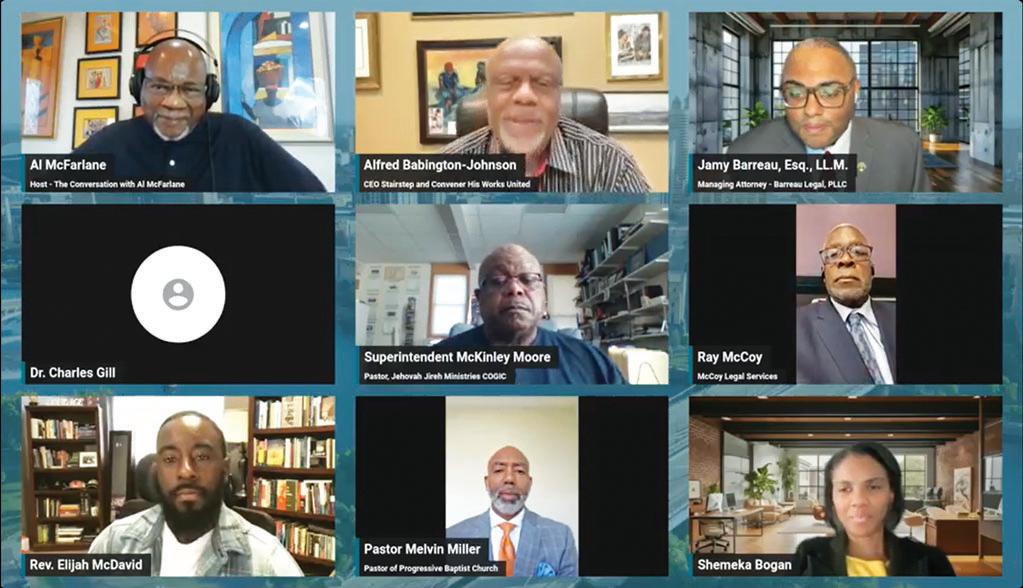
On The Conversation with Al McFarlane on KFAI
prominent Black clergy, including Reverend Alfred Babington Johnson (His Works United), Reverend Dr. Charles Gill (Pilgrim Baptist Church), Pastor Elijah McDavid (Fellowship Missionary Baptist Church), and Reverend Melvin Miller (Progressive Baptist Church), discussed faith, voter mobilization, and the rise of Christian nationalism. In Part 1, the panel emphasized the Black church’s role in political engagement and the importance of initiatives like Souls to the Polls to sustain civic participation. In this second segment, the focus shifts to the dangers of disinformation, the impact of AI on elections, and the need to equip communities—especially youth—to critically engage with political narratives and technology.
By Stacy M. Brown NNPA Newswire Senior National Correspondent @StacyBrownMedia
As Election Day draws closer, the divide between Kamala Harris and Donald Trump has become a chasm. With the help of well-known supporters like Beyoncé, Usher, and Bruce Springsteen who gathered in cities across the country to support her inclusive platform, Harris, the Democratic presidential nominee, has spent the final days of her campaign calling for unity among Americans. Meanwhile, Trump, the Republican nominee, took the stage at Madison Square Garden, delivering a closing pitch that unleashed xenophobic, racially charged rhetoric, painting an America under siege and promising a wave of mass deportations starting on Day 1. Beyoncé joined Harris onstage in Houston, stating, “I’m not here as a celebrity. I’m here as a mother.” Springsteen spoke to Harris’s core values, noting, “She believes in the rule of law and the peaceful transfer of power.” The entertainers championed a vision that they argue will protect democracy, safeguard freedoms, and promote unity—a vision starkly opposed to Trump’s divisive tirade at the World’s Most Famous Arena, where just
said. “It’s not just about geography—it’s a mindset that seeks to undo progress.”
The threat of returning to an era where Black voices were systematically silenced looms large in the minds of community leaders.
Reverend Babington-Johnson agreed, stressing that the battle against disinformation requires vigilance. “We must stay informed and engaged,” Johnson declared. “This isn’t just about who wins the election—it’s about ensuring that those in power serve all Americans, not just a select few.”
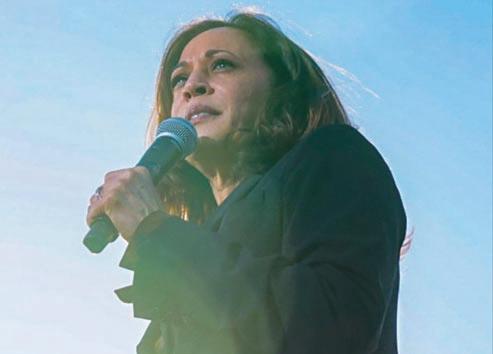
blocks away, Trump was found guilty of 34 felony charges this year and only a few miles from the court that held him responsible for sexual assault. His civil conviction on massive business fraud also occurred across town from The Garden. Trump’s rally, marketed as a historic comeback, was instead a showcase of his campaign’s unrestrained hostility. He anchored his speech on his promise of a massive deportation program, calling the country “occupied” by immigrants—a message reminiscent of historical demagogues. Outside, the Democrats made their own statements, projecting the messages “Trump is Unhinged” and “Trump Praised Hitler” across the storied arena’s exterior. Before Trump even reached the podium, his supporters stoked racial hatred and fear. Former congressional candidate David Rem attacked Harris, calling her “the antichrist” and “the devil” while waving a cross. Comedian
The urgency of this message was clear, especially as discussions turned toward how young people can play a critical role in combating misinformation. McDavid highlighted the importance of engaging young people, especially as AI becomes increasingly influential. “Our youth are already techsavvy,” he said. “We need to empower them to use technology responsibly and critically, equipping them for future careers while protecting democracy.” Bogan emphasized that efforts like Souls to the Polls are part of a broader strategy to keep communities connected beyond election day. “We have to build trust and maintain conversations year-round,” she said. “It’s about ensuring that everyone
By Adam Shapiro, CEO/ President ASPR
Martin Luther King III, the son of revered civil rights icons Dr. Martin Luther King Jr. and Coretta Scott King, directly tied his parents’ dreams for America to the multi-faith initiative to rescue the historic Scotland African Methodist Episcopal (A.M.E.) Zion Church. King passionately spoke about the Potomac, Maryland church that formerly enslaved congregants built by hand. Yet it’s a modern challenge that caught his attention;
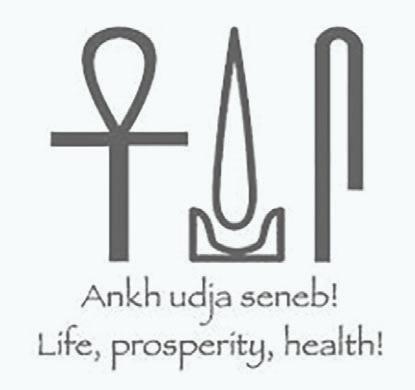
flash flood waters in 2019 and additional weather damage, exasperated by the rerouting of a nearby road, threaten Scotland. King said, “How does it align with ‘I Have a Dream?’ Talk about salvaging and rebuilding…this symbol, this religious institution that provides an opportunity for spiritual learning, is similar to what my dad and mom were doing when they were building the beloved community and Scotland is about building the community.”
King made his remarks at the National Museum of African American History and Culture (NMAAHC), which is only about a mile from the Lincoln Memorial where his father delivered his inspiring “I Have a Dream” speech over 61 years ago. The event at the Smithsonian Museum celebrated the 100th anniversary of Scotland’s founding and its “2nd Century Project,” which is a rescue and rejuvenation initiative under the leadership of Reverend Dr. Evalina Huggins. Bishop Brian R. Thompson Sr. said, “It’s a wonder of Montgomery Country because they wonder how we’re still here! It’s an oasis where people will

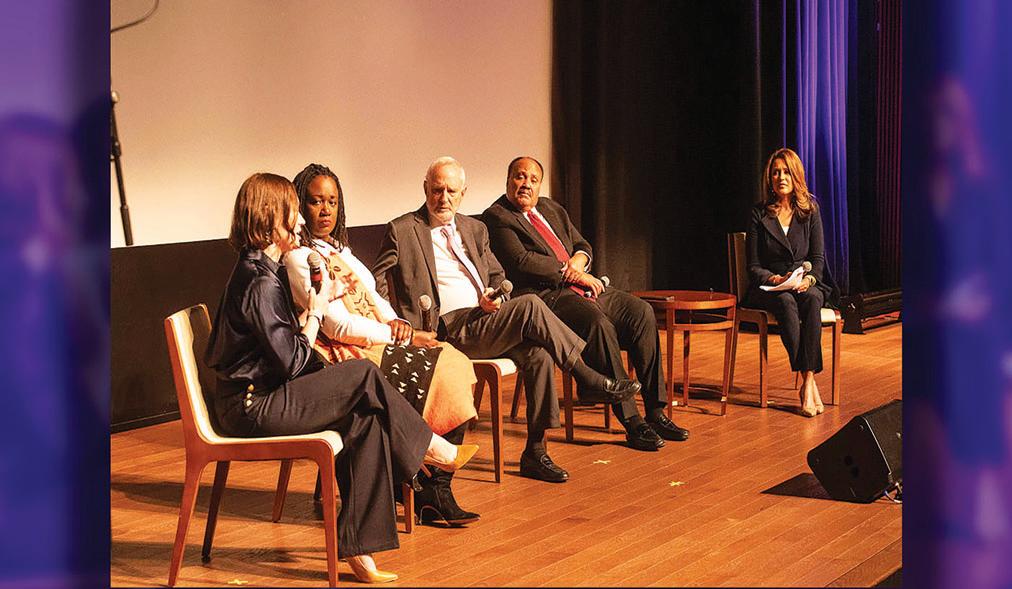
be able to see a symbol of freedom…even though water tried to wipe it away, God is lifting it up higher and higher.” The plans call for rebuilding the historic original structure; regrading the surrounding landscape to mitigate more flooding; and constructing a new state-of-the-art house of worship to meet future needs. Supporters, including Glenstone museum founder Mitch Rales, announced they’d raised nearly $9 million toward the $11 million goal. The NMAAHC event,
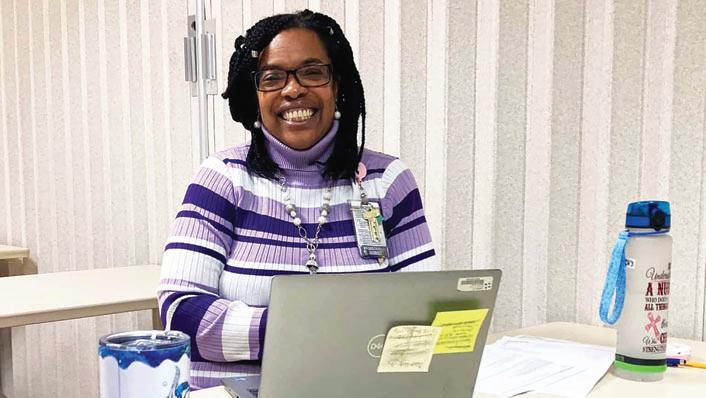
By Pulane Choane Contributing Writer
In a deeply resonant discussion aired on KFAI 90.3FM’s The Conversation with Al McFarlane, the spotlight turned to the urgent need for generational wealth within the Black community. Featuring two legal experts, Ray McCoy and Jamy Barreau, the program previewed the upcoming Black Men’s Legacy Summit III, hosted by Build Wealth Minnesota on October 26, 2024, at the Thor Building in North Minneapolis. The Summit examined practical steps for estate planning, wealth creation, and the preservation of financial legacies.
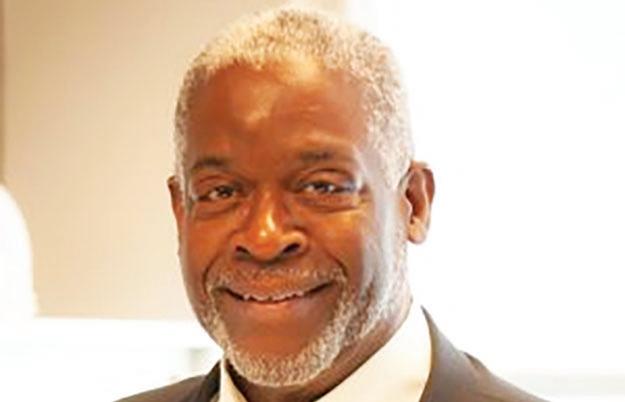
“Wealth Transfer Starts with Planning” Ray McCoy, an estate planning attorney with McCoy Legal Services, emphasized the significance of planning for life’s two certainties: incapacity and death. “The importance of estate planning goes beyond the size of one’s estate,” McCoy said. “Organizing this process ensures that we care for ourselves as we age and transfer assets smoothly when the time comes.” He acknowledged that estate planning remains a neglected topic among many Black families. “Too often, we think we don’t need to plan because we feel we have little to pass on,” McCoy noted. “But having a plan is essential to avoid unnecessary conflict and hardship for our loved ones.” McCoy shared a personal story of his father’s reluctance to engage in estate planning. “He told me, ‘You take care of it,’ without wanting to understand the complexities. But not having these discussions can create lasting problems for those left behind.” McCoy stressed that
By John Lowrey Assistant Professor of Supply
Chain and Health Sciences, Northeastern University
All major supermarkets and retailers that sell groceries, such as Kroger, Walmart and Costco, give large amounts of food to food banks and pantries.
In 2022, retailers donated close to 2 billion pounds of food across the United States, which amounted to US$3.5 billion that year. The estimated value of donated food was a little less than $2 per pound in 2022.
Retailers donate products that are typically packaged, palatable and safe for consumption, yet unsuitable for sale due to quality concerns, such as minor blemishes. Since these items can go a long way to feeding hungry people, donations
represent one of the best uses of leftover or surplus food.
Donations are also technically acts of charity, and the companies responsible for them get tax breaks. This means that donations boost profits by lowering costs. There’s a second effect of donations on a store’s bottom line: They improve the quality of food on the store’s shelves and increase revenue from food sales.
As a supply chain scholar who studies food banks, I worked with a team of economists to estimate the effects of retail food donations. We used sales data for five perishable food categories sold by two competing retail chains, with stores located in a large, Midwestern metropolitan area. We found that stores that remove items on the brink of expiration, donate them to food banks and fill up the emptied shelf space with fresher inventory get more revenue from sales and earn
establishing documents like healthcare directives and wills is critical. “These steps give clarity—who makes decisions if I’m incapacitated, and how will my assets transfer without the complications of probate?”
Avoiding Probate Pitfalls Jamy Barreau, Managing Attorney at Barreau Legal, expanded on the challenges probate court presents, especially for families without an estate plan.

“Probate is the legal process of transferring assets to the next of kin,” Barreau explained. “But it can take 12 to 18 months, depending on the state, and it often involves high court and attorney fees.” Barreau highlighted the emotional toll probate can impose. “It’s not just a financial burden; it can create friction among family members over who gets what,” he said. “With proper planning, you can name an executor to handle your affairs and avoid disputes. If no executor is chosen, the state could step in, which can complicate things even more.”
When asked by McFarlane if families risk losing wealth by neglecting planning, Barreau responded: “Absolutely. Failing to plan opens your estate to unnecessary liabilities like estate taxes, reducing the wealth passed down. While it’s rare for assets
to default to the state, without proper preparation, families can still lose out in other ways.”
Generational Wealth Gains Momentum
McFarlane noted a cultural shift towards financial literacy within the Black community, referencing how celebrities like Tiffany Haddish have amplified conversations about generational wealth.
Barreau agreed, saying, “I’m encouraged by this movement. More clients are coming to us, recognizing the value of their assets—whether it’s a home, rental property, or savings— and wanting to build something lasting for their children.” McCoy added a
broader context, tying the conversation to the push for reparations. “Cities like St. Paul, where I serve on the Reparations Commission, are engaging in discussions about addressing the legacy of slavery and the wealth it denied Black families,” he said. “The ability to transfer wealth from one generation to the next is crucial for breaking cycles of economic disenfranchisement.”
A Community Call to Action The summit, themed Reclaiming Control of Our Future, is part of Build Wealth Minnesota’s ongoing effort to empower Black families through financial education. Led by David McGee and Jeffrey Robinson, the organization has a long-standing mission to help families transition from a position of lack to financial
higher profits.
Retailers donate 30% of what food banks give their clients U.S. food banks, which have been operating for more than 50 years, give away over 6 billion pounds of food annually. They get about 30% of that food for free from supermarkets and big-box retailers that sell groceries. Prior to the start of the COVID-19 pandemic, retailers supplied more than twice as much food to food banks than the federal government did. The volume of food supplied by federal programs administered by the United States Department of Agriculture, such as the Emergency Food Assistance Program, have steadily increased since 2020, to now almost match the volume of food donated by retailers.
In 2022, for example, the network of more than 200 Feeding America member food banks procured about 2 billion pounds from retailers and almost 1.5 billion pounds from government programs.
The remaining 2.88 billion pounds of food were either purchased directly, provided by farmers, donated by food processing companies or donated by people and organizations in local communities.
Despite several federal programs that help lowincome people get food and the nation’s robust network of food banks and food pantries, nearly 50 million Americans are experiencing food insecurity. That means they can’t get

enough nutritious food to eat at least some of the time.
Retail donation routines are established but inconsistent
When food on a store’s shelves is on the verge of expiration, store managers have three options. They can donate or discard it, or sell it at a discount.
Stores that regularly donate food have established routines for when they set aside about-to-expire food to give away. However, these routines are often inconsistent.
Many stores donate only on a seasonal basis or just give away certain kinds of food.
For example, they might donate only meat, baked goods or fruits and vegetables. In many cases, donations take a backseat to more immediate priorities, such as customer service.
Those realities can increase the likelihood that food will land at the dump instead of on somebody’s table.
Although millions of Americans struggle to find their next meal, close to 40%
of food gets thrown out along the supply chain, as food moves between agricultural producers, factories, retailers and consumers. This is largely due to logistical challenges: It’s hard to transport and distribute highly perishable food.
Discounts on food can undercut sales
Stores often prefer to sell food on the brink of expiration at a discount rather than donate it or throw it out due to the money they recoup that way. This option, however, also keeps the discounted food on the shelf, where it takes up valuable space that could otherwise hold fresher inventory.
Shelf space dedicated to the sale and promotion of fullpriced products competes with that for price-discounted food. Stocking perishable foods that are starting to look iffy – such as bananas with brown spots sold alongside unblemished yellow bananas – could harm a retailer’s image if shoppers start to question the store’s quality.






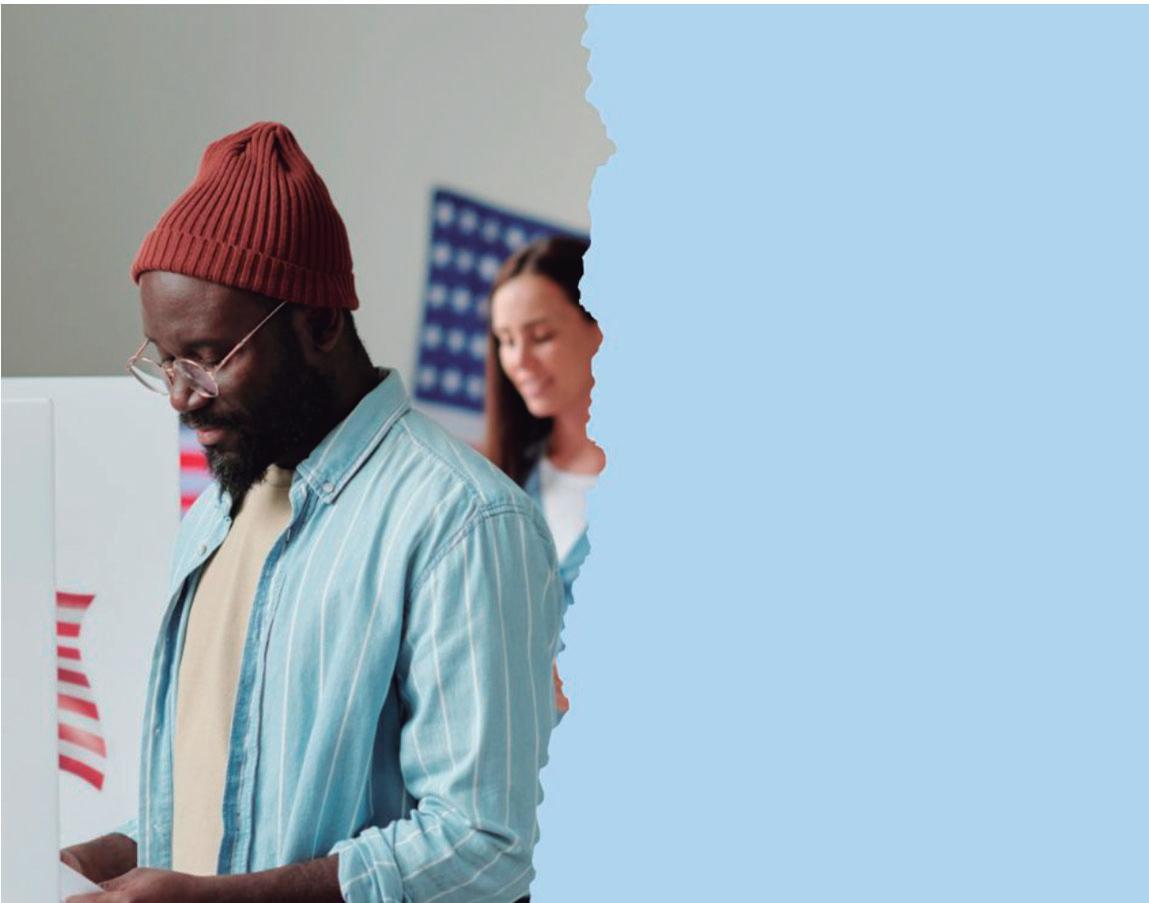




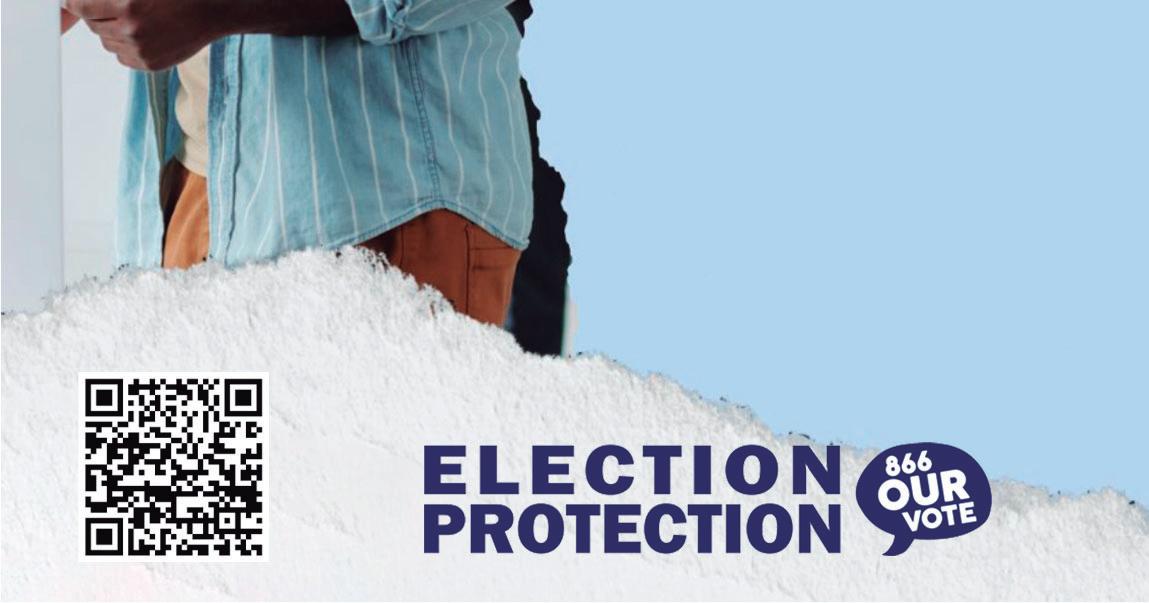


In other words, if consumers make judgments based on all the produce that’s on display, then it may be better for stores if they don’t sell sad-looking bananas and instead just give them away. My research team calls this practice “preemptive removal.” Increasing the average quality level of food on display does more than improve a store’s appearance. We used panel data with over 20,000 observations, and we included 21 retail stores that compete in a similar market geography. The five fresh food categories were bakery, dairy, deli, meat and produce. Stores that donated food, instead of discounting it, may have made better use of the limited room to display fresher inventory. My research team found that food donations can increase average food prices by up to 1%, which corresponds to a 33% increase in profit margins. Profit margins for supermarkets and other food retailers are quite low and typically hover below 3%. That means even a small increment in food prices, even a 1% bump up, can translate into significantly higher profits for retailers. At the same time, increasing the volume of retail food donations would get more food to people who need it, limit hunger and reduce food insecurity. Prof Lowrey has consulted with several Feeding America member Food Banks on procurement and fooddistribution-related supply chain projects. He has also served on an advisory board to the Academy of Nutrition & Dietetics, focused on supply chain responses to the
From 3
line, and every vote matters.” Rosell echoed this anxiety but framed it in broader terms: “People are not just voting on a candidate. They’re voting on what they believe America stands for.”
Disillusionment with Both
Parties: “Pro-Genocide Policies”
Rosell, who works closely with communities across Minnesota, introduced a provocative stance: neither party, in his view, offers a meaningful alternative on foreign policy. “Both are pro-genocide,” he argued, referencing U.S. support for Israel’s military actions in Gaza. “How can we feel good about voting when we fund weapons that destroy entire families?”
He said that, for him, the
election has become a matter of principle. “I’ve made a commitment—I won’t vote for anyone who backs genocide.”
This sentiment resonated with Mgeni, but he stressed the risks of abstaining from voting. “Trump’s win in Michigan in 2016 came down to 10,000 votes. A protest vote— or not voting at all—could tip the scales again,” he warned. Palmer added nuance to the debate, cautioning against single-issue voting. “It’s dangerous to fixate on one issue, even one as urgent as Gaza,” he said. “We still need to think about healthcare, reproductive rights, and the economy. If we ignore these, we risk unintended consequences.”
The Electoral College: A Legacy of Inequity
The panel’s discussion naturally flowed into an exploration of systemic barriers, including the Electoral College. Palmer explained how the institution traces back to slavery, designed to balance
power by counting enslaved people as three-fifths of a person. “The Electoral College is a tool that never reflected true democracy,” he stated. “It was built to suppress representation from the start.”
Mgeni pointed out how modern voter suppression mirrors these historical injustices. “In North Carolina, they closed 238 early voting sites, leaving only two open— once a month,” he said. “It’s a deliberate strategy to keep people of color away from the polls.”
Rosell emphasized how these systemic issues contribute to voter apathy. “When people see how broken the system is, they ask, ‘Why bother voting?’” he said. “And when they watch billions of their tax dollars fund wars, it deepens that disillusionment.”
Foreign Policy and Domestic Frustration: A Vicious Cycle
Rosell delved deeper into the impact of U.S. foreign policy, particularly in Gaza,
tying it back to the broader loss of trust in American leadership. “We tell kids not to be bullies, but our country bullies the world,” he said. “How do we reconcile that hypocrisy?” He pointed out that support for Israel’s military actions alienates many Minnesotans, especially those with ties to marginalized communities around the world. “It’s hard to see a difference between Trump and Harris on these issues,” he argued. “Both perpetuate the same violent policies.”
McFarlane challenged Rosell on this point, asking whether a vote for neither candidate would, in effect, be a vote for Trump. Rosell remained steadfast. “They’ve told us for years to vote for the lesser evil,” he responded. “But it’s still evil. I refuse to participate in that game.”
Balancing Principles and Pragmatism
Palmer acknowledged Rosell’s frustration but urged listeners to consider the stakes.
“It’s not about sacrificing your principles,” he said. “It’s about recognizing that not all change happens at once. Sometimes, not losing is a victory.”
He emphasized that even small policy shifts—such as preserving healthcare access— can have a profound impact.
“It’s a tough balance,” Palmer admitted, “but the consequences of another Trump term would be catastrophic.”
The conversation ended on a note of solidarity.
Mgeni expressed his admiration for Rosell’s principled stand but reminded listeners that activism doesn’t stop with voting.
“We must fight for peace in Gaza, here in Minnesota, and everywhere,” he said. “But we also have to play the long game.”
Engaging the Community
Beyond the Ballot Box
Throughout the show, McFarlane encouraged listeners to engage with the conversation and their communities. “Our democracy depends on these
debates,” he said, inviting Minnesotans to reflect on the issues raised. “Whether you agree or disagree, your voice matters.”
As the panelists shared personal reflections and policy critiques, the conversation revealed the difficult choices many voters face this election season. With issues ranging from foreign policy to voter suppression, the stakes have never felt higher. Yet, the panelists also underscored the importance of maintaining hope and continuing the fight for justice—both at home and abroad.
McFarlane signed off with a call to action: “Whatever you decide on November 5th, stay engaged. Our future depends on it.” Listeners can catch The Conversation with Al McFarlane live on KFAI or stream it on Facebook, YouTube, and Twitter.
From 3
Tony Hinchcli
ffe plunged into outright racism, referring to Puerto Rico as “a floating island of garbage” and demeaning Latinos with, “These Latinos, they love making babies, too.”
From 3
King III III
From 3
moderated by WUSA9 news
anchor Lesli Foster, served as a powerful reminder of Scotland’s importance, even for those who don’t worship there. Longtime Bethesda resident Joyce Siegel was recognized for her work to revitalize the Scotland community, including the church, in the 1960s.
Frank Islam, a philanthropist and Muslim, said that he and his wife Debbie Driesman quickly embraced the effort. “The 2nd Century Project has brought together the broader community in a common cause. It’s a remarkable effort, especially at a time when we need more opportunities to work together as Americans.”
Rabbi David Saperstein, U.S. Ambassador-at-Large for International Religious Freedom, reflected that the wide-ranging support illustrated the Bible’s lesson to “Love your neighbor as yourself.” In fact, Rabbi Evan Krame and members of his nearby Jewish congregation made the first donation.
Amy Spitalnick, CEO of the Jewish Council for Public Affairs, and others reflected on the longstanding ties between Jewish and Black communities to push back against antisemitic and anti-Black actions, from Selma, Alabama, in the 1960s to the more recent violent marches in Charlottesville, Virginia, and other locations.
High school student Alice Carrie Marriott highlighted the importance of young people creating ties as she spoke about being a member of The Church of Jesus Christ of Latter-day Saints and her commitment to Dr. King’s dream in the 21st century.
Dr. Erika Gault, Director of the Center for the Study of African American Religious Life at NMAAHC, spoke about the diversity of religions in Black culture, including Blacks who are practicing Jews and Buddhists. She also explained the evolving definitions of
Radio host Sid Rosenberg went further, railing against migrants living in New York and declaring, “You got homeless and veterans—Americans— sleeping on their own feces on a bench in Central Park. But the f**king illegals, they get whatever they want, don’t they?” Trump’s speech bristled with falsehoods and conspiracy-laden claims.
understands the power they hold—not just during elections, but every day.”
This long-term vision reflects a growing awareness that civic engagement must be
Echoing his 2016 rhetoric, he argued that migrants are to blame for economic woes, pushing the narrative that his leadership alone could restore prosperity. “Are you better off now than you were four years ago?” he asked, promising to end inflation and “bring back the American dream” despite his previous term’s failure. His speech underscored the
extremist shift that defines his campaign—a willingness to blame society’s ills on the most vulnerable, in line with far-right leaders who have exploited fear and division throughout history.
Harris’s campaign has drawn strength from powerful allies who recognize the stakes.
Reflecting on Trump’s divisive legacy, Tyler Perry said, “In this Donald Trump America, there is no dream that looks like me.”
Samuel L. Jackson, standing firmly behind Harris, reminded audiences, “She’s running on a proven track record of fighting for the people… of taking on the toughest fights.” Harris
continuous to create lasting change. The conversation concluded with a call to action. “This isn’t just about politics—it’s about
religious involvement in today’s culture. In addition, Rep. Jamie Raskin (D-8th District) presented the church with a congressional proclamation for its efforts
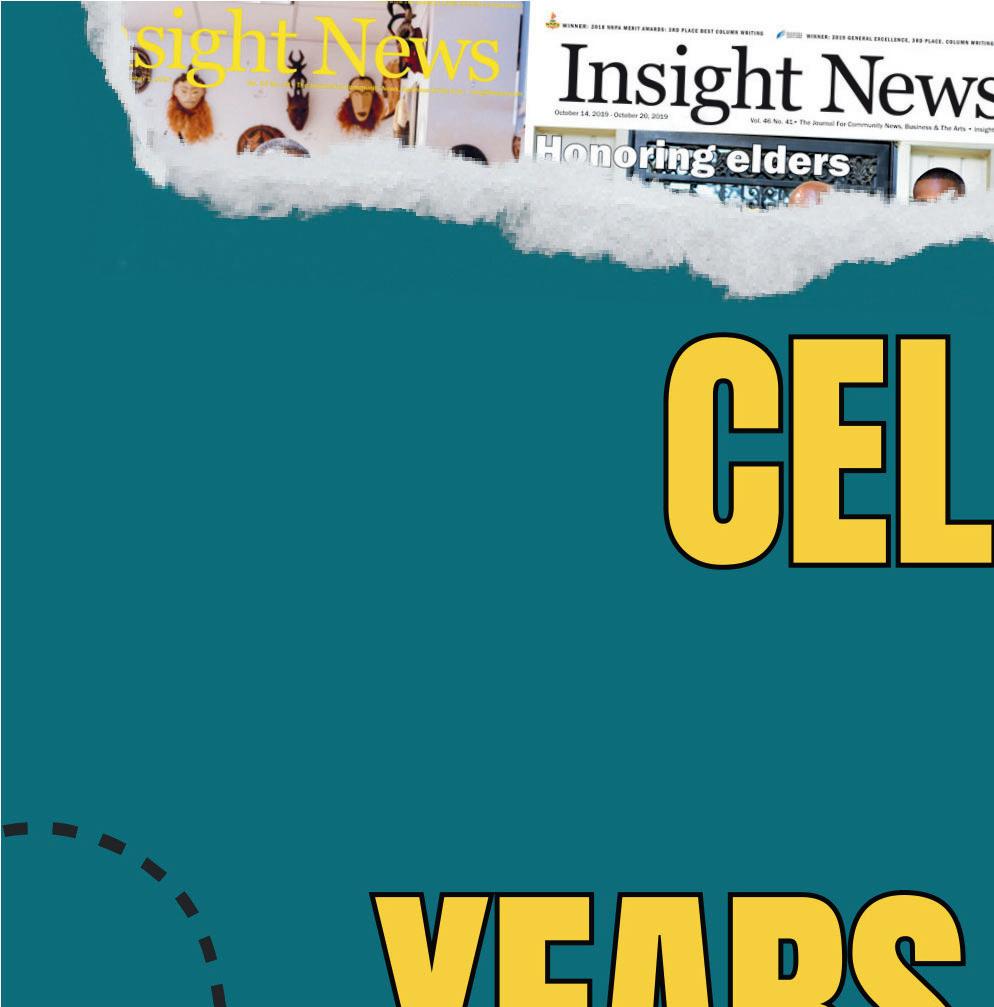


Harris’s final rally, scheduled for Tuesday, will occur on the Ellipse in Washington, D.C., a deliberate echo of the January 6, 2021, insurrection that Trump incited.
reclaiming our story,” McFarlane reflected. “We owe it to those who fought before us, and we owe it to future generations.” With the Black
to preserve and build on its important legacy. As the church’s choir sang “I Want
Bruce Springsteen declared, “There is only one candidate in this election who holds those principles dear: Kamala Harris… Trump is running to be an American tyrant. He does not understand this country, its history, or what it means to be deeply American.”
Men’s Legacy Summit III on the horizon and voter mobilization efforts in full swing, Minnesota’s Black leaders are united in their mission: to confront

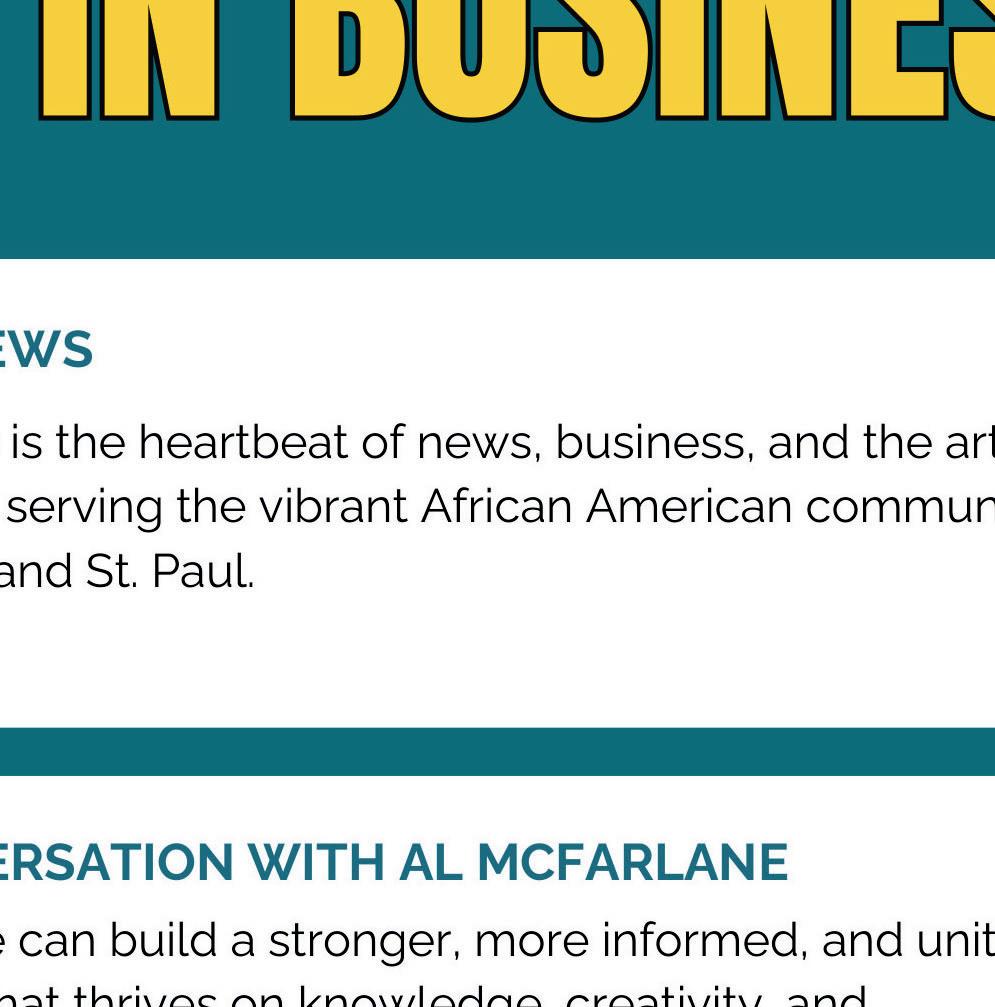
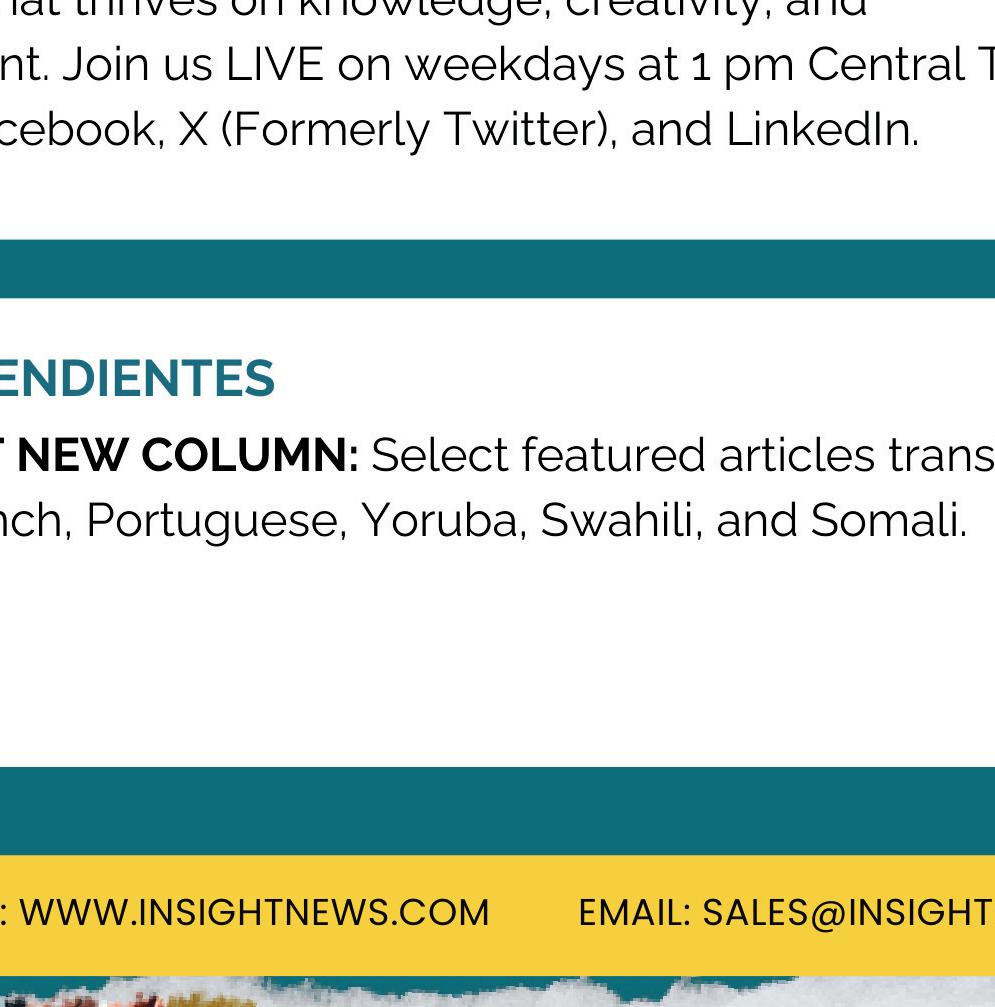

disinformation, engage the community, and shape a future rooted in justice and equality. As McDavid put it, “We’re not just voting— we’re building a movement.”

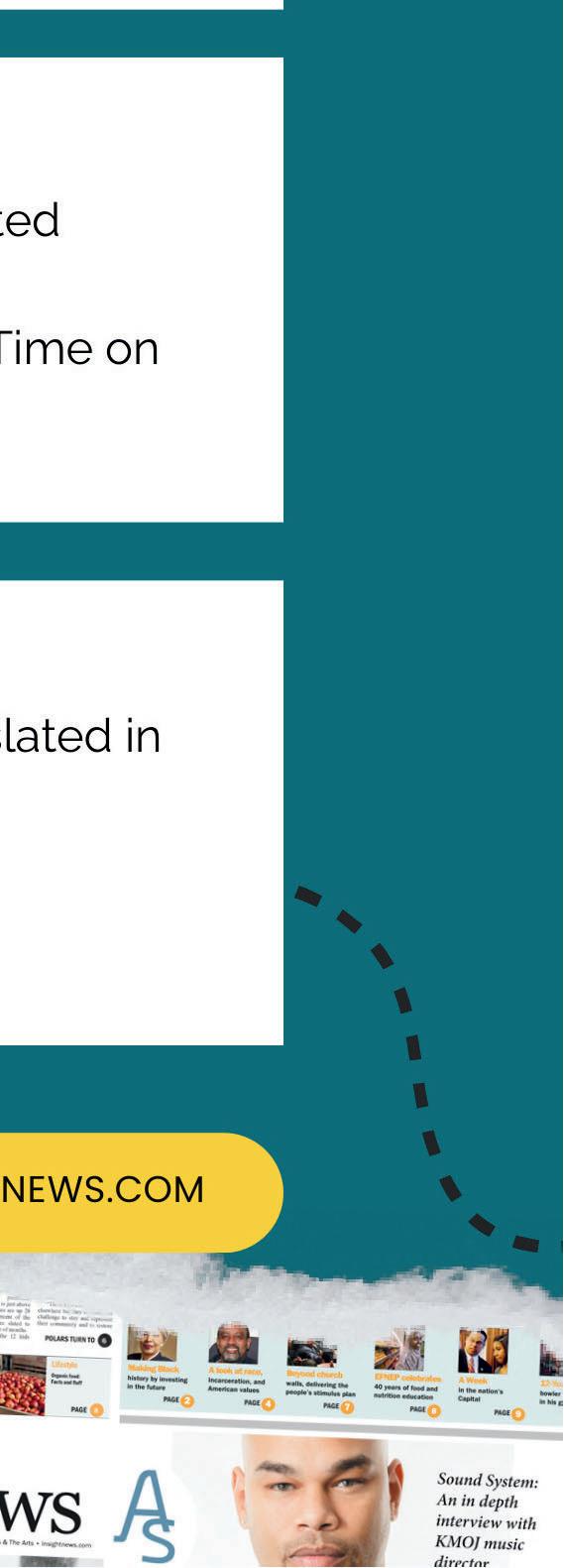

merece”.
Parte 2 de 3
“Tan absurdo como es estúpido”
Pero a pesar de toda su aparente autoridad, la lectura del requerimiento fue un ejercicio absurdo. Primero ocurrió en
lo que ahora es Santa Marta, Colombia, durante la expedición dirigida por Pedrariasdávila en 1513. Un testigo ocular, el cronista Gonzalo Fernández de Oviedo, declaró lo obvio: “No tenemos a nadie aquí que pueda ayudar [las personas indígenas] que entienden] entendiendo] él.”
Sin embargo, incluso con un traductor, el documento, con sus elevadas referencias
a la creación bíblica del mundo y la autoridad papal, difícilmente sería inteligible para las personas que no están familiarizadas con la religión de los españoles. Explicar el documento contorneado requeriría nada menos que una larga recitación de la historia católica.
Oviedo sugirió que para dar semejante conferencia, primero habría que capturar y
enjaular a un indígena. Incluso si el documento había sido comprendido en su totalidad. Sin embargo, para el mayor crítico del Requerimiento, Bartolomé de las Casas, la traducción era sólo uno de los muchos problemas. Un misionero de España, Las Casas criticó el espurio requisito en sí mismo: que se debe esperar que un pueblo se
convierta inmediatamente a una religión que acaba de descubrir que existe, y “jurar lealtad a un rey del que nunca han oído hablar ni visto, y cuyos súbditos y embajadores resultan ser tiranos crueles, despiadados y sedientos de sangre. … Tal noción es tan absurda como estúpida y debe ser tratada con la falta de respeto, el desprecio y el desprecio que tan ampliamente
Las Casas, que documentó los abusos contra los indígenas en múltiples libros y discursos, fue uno de los denunciantes más abiertos de la crueldad española en las Américas. Aunque creía que los españoles tenían el derecho e incluso la obligación de convertir a los indígenas al catolicismo, no creía que la conversión debiera realizarse bajo amenaza de violencia.
Parte 2 de 3


authority, the reading of the Requerimiento was an absurd
is now Santa Marta, Colombia, during the expedition led by Pedrarias Dávila in 1513. An eyewitness, the chronicler Gonzalo Fernández de Oviedo, stated the obvious: “we have no one here who can help [the Indigenous people] understand it.”
Even with a translator,
though, the document – with its lofty references to the Biblical creation of the world and papal authority – would hardly be intelligible to people unfamiliar with the Spaniards’ religion. Explaining the convoluted document would require nothing less than a long recitation of Catholic history.
Oviedo suggested that to deliver such a lecture, you’d
“Tão absurdo quanto estúpido” Mas, apesar de toda a sua aparente autoridade, a leitura do Requerimiento foi um exercício absurdo. Ocorreu pela primeira
vez no que agora é Santa Marta, Colômbia, durante a expedição liderada por Pedrariasdávila em 1513. Uma testemunha ocular, o cronista Gonzalo Fernández de Oviedo, declarou o óbvio: não temos ninguém aqui que possa ajudar [as pessoas indigenas] entendem isto.”
Mesmo com um tradutor, porém, o documento - com suas referências elevadas à criação
bíblica do mundo e da autoriinteligível para as pessoas não familiarizadas com a religião dos espanhóis. Explicar o documento complicado exigiria nada menos que uma longa recitação da história católica. Oviedo sugeriu que, para fazer tal palestra, você teria que primeiro capturar e enjaular um indígena. Mesmo assim, seria
Indigenous person. Even then, it would be impossible to verify whether the document had been fully understood. However, for the Requerimiento’s greatest critic, Bartolomé de las Casas, translation was merely one of many problems. A missionary from Spain, Las Casas criticized the spurious requirement itself: that a people should be expected to immediately convert to a
religion they have only just learned exists, and “swear allegiance to a king they have never heard of nor clapped eyes on, and whose subjects and ambassadors prove to be cruel, pitiless and bloodthirsty tyrants. … Such a notion is as absurd as it is stupid and should be treated with the disrespect, scorn and contempt it so amply deserves.”
Las Casas, who
documented abuses against Indigenous people in multiple books and speeches, was one of the most outspoken denouncers of Spanish cruelty in the Americas. While he believed Spaniards had a right and even an obligation to convert Indigenous people to Catholicism, he
umento havia sido totalmente compreendido. No entanto, para o maior crítico do Requerimiento, Bartolomé de las Casas, a tradução era apenas um dos muitos problemas. Um missionário da Espanha, Las Casas criticou a exigência espúria em si: que um povo deveria se converter imediatamente a uma religião que
eles acabaram de descobrir que existe, e “jurar lealdade a um rei do qual nunca ouviram falar nem viram, e cujos súditos e embaixadores provam ser tiranos cruéis, impiedosos e sanguinários. … Tal noção é tão absurda quanto estúpida e deve ser tratada com o desrespeito, o desprezo e o desprezo que tanto merece.”
Las Casas, que documentou abusos contra indígenas em vários livros e discursos, foi um dos denunciantes mais francos da crueldade espanhola nas Américas. Embora acreditasse que os espanhóis tinham o direito e até a obrigação de converter os indígenas ao catolicismo, ele não acreditava que a conversão deveria ser feita sob ameaça de violência.
conférence, il faudrait d’abord capturer et mettre en cage un autochtone. Même dans ce cas, il serait impossible de entièrement compris.
Cependant, pour le plus grand critique du
Qaybta 2 ee 3
‘Sida aan macquul ahayn sida ay nacasnimadu u tahay’ Laakiin dhammaan awooddeeda u muuqata, akhrinta Requerimiento waxay ahayd layli aan macquul ahayn. Waxay markii ugu horreysay ka dhacday waxa
Requerimiento, Bartolomé de las Casas, la traduction n’était qu’un problème parmi tant d’autres. Un missionnaire espagnol, Las Casas, a critiqué l’exigence elle-même : qu’un peuple soit tenu de se convertir immédiatement à une religion
hadda loo yaqaan Santa Marta, Colombia, intii lagu jiray socdaalkii uu hoggaaminayay PedrariasDávila ee 1513. Goobjooge, taariikhyahan Gonzalo Fernández de Oviedo, ayaa yidhi: “Ma haysanno qof halkan ku caawin kara [dadka asaliga ah] inay fahmaan waa.” Xitaa turjumaan, in kastoo, dukumeentiga - oo leh tixraaciisa sare ee ku saabsan abuurista Kitaabka Qudduuska ah ee adduunka iyo awoodda
dont il vient à peine d’apprendre l’existence, et “ de prêter serment d’allégeance à un roi dont il n’a jamais entendu parler ni vu les yeux, et dont les sujets et les ambassadeurs se révèlent être des tyrans cruels, impitoyables
papal - waxay noqon doontaa mid aan la fahmi karin dadka aan aqoon diinta Isbaanishka. Sharaxaada dokumentiga la isku daray uma baahna wax ka yar akhrin dheer oo taariikhda Katooliga ah. Oviedo waxa uu soo jeediyay si aad u jeediso muxaadaradan oo kale, waa in aad marka hore soo qabataa oo ah. Xataa markaas, suurtagal ma noqon doonto in la xaqiijiyo
et sanguinaires. […] Une telle idée est aussi absurde que stupide et devrait être traitée avec le manque de respect, le mépris et le mépris qu’elle mérite amplement. “ Las Casas, qui a documenté les abus contre les
in dukumeentiga si buuxda loo fahmay iyo in kale. Si kastaba ha noqotee, dhaleeceynta ugu weyn ee Requerimiento, Bartolomé de las Casas, tarjumaaddu waxay ahayd kaliya mid ka mid ah dhibaatooyin badan. Adeege ka yimid Isbaanishka, Las Casas ayaa dhaleeceeyay shuruudda
inay isla markiiba u beddelaan diin ay hadda uun barteen, iyo “Ku dhaarta in aad
peuples autochtones dans de nombreux livres et discours, était l’un des dénonciateurs les plus virulents de la cruauté espagnole dans les Amériques. Bien qu’il croyait que les Espagnols avaient le droit et même l’obligation de convertir
daacad u noqotaan boqor aanay weligood maqlin oo aanay sacabka ku sacabin, oo dadkiisa inay yihiin arxanlaawayaal, naxariis la’aan iyo dhiigmiiratada. … Fikirka noocan oo kale ah waa mid caqli-gal ah sida uu nacasnimo u yahay waana in lagu ixtiraamaa ixtiraam darro, quudhsi iyo quudhsi si uu u qalmo.” Las Casas, oo buugaag iyo khudbado badan ku qoray
les peuples autochtones au catholicisme, il ne croyait pas que la conversion devait se faire sous la menace de la violence.
Sehemu ya 2 ya 3
‘Upuuzi kama huo ni ujinga’ Lakini kwa mamlaka yake yote, usomaji wa Requerimiento ulikuwa ni zoezi la kipuuzi. Ilitukia mara ya kwanza katika eneo ambalo sasa linaitwa
Santa Marta, Kolombia, wakati wa msafara ulioongozwa na PedrariasDávila mwaka wa 1513. Shahidi aliyejionea matukio hayo, mwandishi wa matukio Gonzalo Fernández de Oviedo, alisema jambo lililo wazi: “hatuna mtu yeyote hapa anayeweza kuwasaidia [Wenyeji] kuelewa. hilo.” Hata hivyo, hata ikiwa na mtafsiri, hati hiyoyenye marejezo yake makuu
kuhusu uumbaji wa Biblia wa ulimwengu na mamlaka ya papa - haiwezi kueleweka kwa watu wasiojua dini ya Wahispania. Kufafanua hati yenye utata kungehitaji kusoma kwa muda mrefu historia ya Kikatoliki. Oviedo alipendekeza kwamba ili kutoa mhadhara kama huo, itabidi kwanza umnase na kumfunga mtu wa kiasili. Hata hivyo, haingewezekana kuthibitisha
kama hati hiyo ilikuwa imeeleweka kikamilifu. Hata hivyo, kwa mchambuzi mkuu wa Requerimiento, Bartolomé de las Casas, kutafsiri kulikuwa tu mojawapo ya matatizo mengi. Mmishonari kutoka Uhispania, Las Casas alikosoa hitaji lenyewe la uwongo: kwamba watu wanapaswa kutarajiwa kugeukia mara moja dini ambayo wamejifunza tu ipo, na
“kuapa utii kwa mfalme ambaye hawajapata kumsikia na ambaye raia wake na mabalozi wake huthibitika kuwa watawala wakatili, wasio na huruma na wenye kiu ya kumwaga damu. ... Wazo kama hilo ni la kipumbavu kama vile ni la kijinga na linapaswa kutendewa bila heshima, dharau na dharau inayostahili sana.” Las Casas, ambaye
xad-gudubyada ka dhanka ah dadka asaliga ah, waxa uu ahaa mid ka mid ah dadka sida aadka ah u cambaareeyey naxariis-darrada Isbaanishka ee Ameerika. Inkasta oo uu rumaysnaa in Isbaanishka ay xaq u leeyihiin iyo xitaa waajib ku ah inay dadka asaliga ah u beddelaan Catholicism, ma uusan rumaysnayn in beddelka lagu sameeyo khatarta rabshadaha.
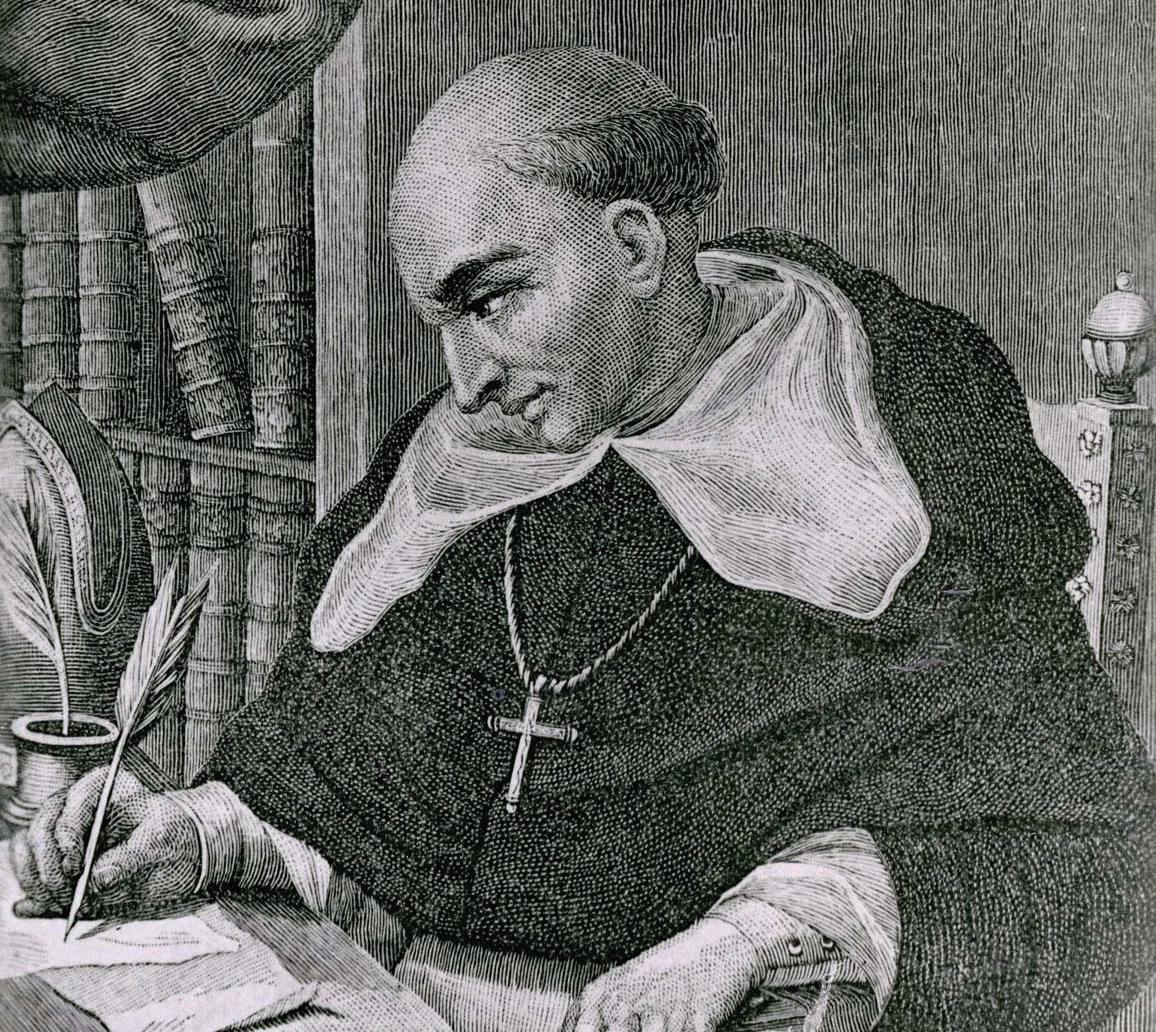

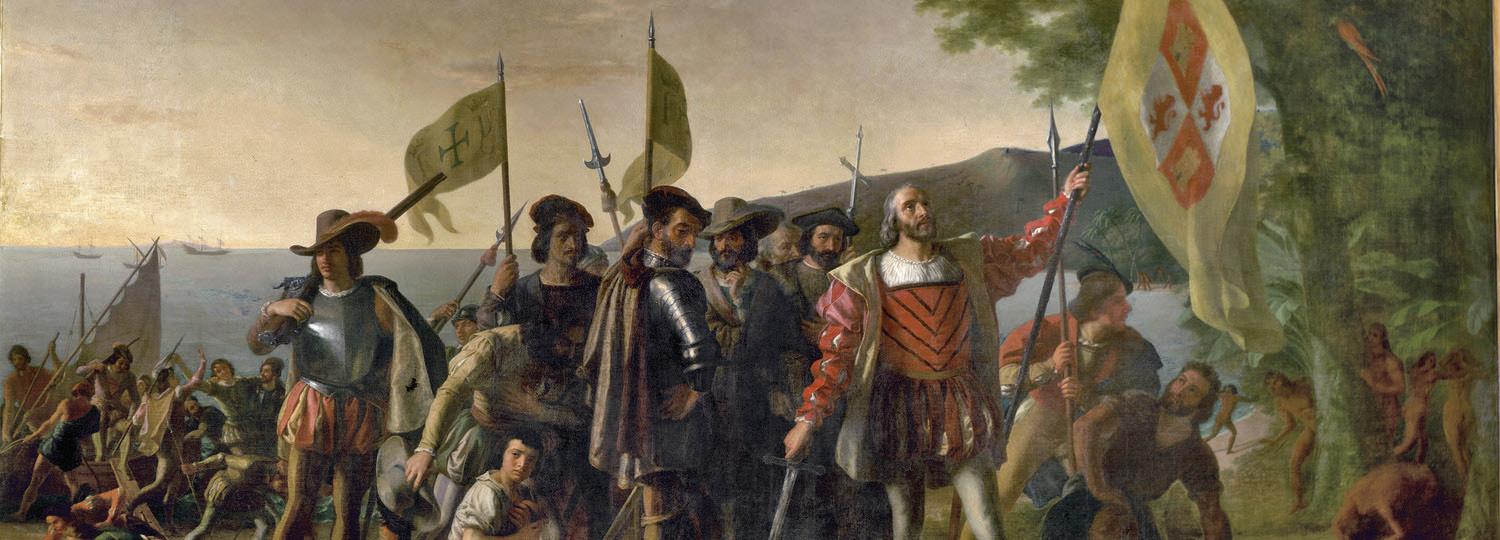
By Britt Robson MinnPost
The Minnesota Timberwolves of 2024-25 are a different beast than the other 35 iterations we have seen from this franchise. They are a squad flush with success and plush with goodwill, focused and unified, save for an unsavory ownership squabble that thankfully should have little-to-no bearing on the course of play between now and when they finish at a yet-to-be determined point sometime next Spring.
The only other time this franchise came into a season fresh off a pair of playoff series victories, Latrell Sprewell was haughtily rejecting a threeyear contract extension just three days before the team’s home opener in 2004-05, setting in motion a toxic chain collision of distraction and disillusionment that would force the firing of coach Flip Saunders after 51 games, while the Wolves fell out of the playoff picture for the next 13 years.
The team’s next trip to the postseason was in 201718, the apex of the bristling but brief Thibodeau-Butler era, which disintegrated via another player snit-cum- sabotage that lopped off the head of the coach and sent the Wolves tumbling down the standings.
The Wolves of 2425 are without their senior star from the year prior, having dealt Karl-Anthony Towns to the Knicks earlier this month. Yet there is a through-line of integrity running through this operation now, from President of Basketball Operations Tim Connelly to head coach Chris Finch to veteran leaders Rudy Gobert and Mike Conley, franchise superstar Anthony Edwards and his brethren Naz Reid and Jaden McDaniels, and even to the newcomers fetched in the KAT trade, Donte DiVincenzo and Julius Randle.
Bottom line, on the cusp of their 36th campaign,
the Timberwolves have never looked more organizationally capable of enduring the myriad rigors of an 82-game regular season and entering the crucible and carnival of the playoffs with a potent blend of hunger, experience and synergistic talent. That said, looks can be deceiving. Every NBA season, a betting favorite or two slowly but surely goes belly-up due to a poisonous porridge that can include injuries, mysterious regressions, off-court melodramas and dreadfully-timed bad luck. Winning consistently is hard; the formula concocted for it needs to be reliable but not too staid, and coupled with antidotes for strife and malaise hastily rendered when needed.
Yes, these Wolves on opening day have never looked stronger. But the Western Conference in which they compete has never looked deeper or more rugged. Ten of the 15 teams in the conference won at least 46 games last season (10 games over .500) and half of those won 50 or more. This season, three of those five teams below 46 wins — Memphis, Houston and San Antonio — figure to be significantly improved while none of the top 10t last season look significantly worse.
As with last year’s season preview, what follows are the X-factors, framed as key questions, that I believe will determine how successful the Wolves can be in 202425, at least in terms of issues roughly under their control. My predicted win total and playoff seeding will be provided at the end, and if you subscribe (for free) to the And-One newsletter, I’ll give you my predicted standings in both the Eastern and Western conferences, with a sentence or two about each team.
Key questions
How does coach Finch structure his frontcourt rotations in a manner that retains



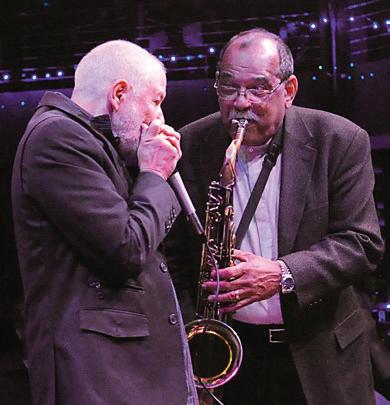
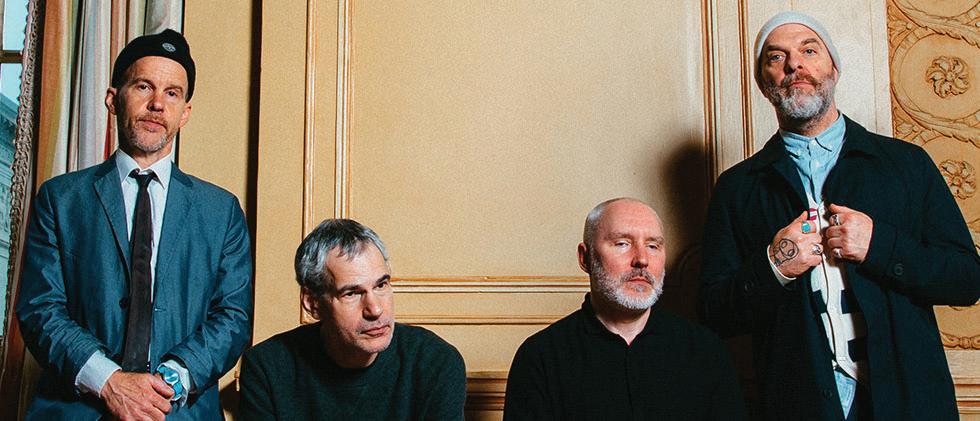

a top-tier defense while creating a more productive identity (or identities) for the offense?
For the past two seasons, Gobert was the starting center and KAT slid over from power forward to play center when Gobert rested. Naz was the power forward off the bench who played beside each one. Before KAT was traded, Finch toyed with the idea of getting Naz more involved via a “3 bigs” frontcourt in which he would occasionally play small forward beside both Gobert and KAT. In terms of the frontcourt, the trade essentially swaps out KAT for Randle. While both have performed well enough to be named to multiple All Star teams, they are very different players. In the modern game, KAT is a natural “stretch five,” a big man who is a superior long-range shooter who can rebound and protect the rim but can also be overmatched on defense. Randle is a natural “bully-ball four,” a bruising power forward who can get a basket on his own in isolation, but lacks the overall range and efficiency of KAT on offense. On defense, he is less of a rim protector but better guarding in space and in overall mobility. Then there is Naz,





who came into the NBA as an overweight, top-heavy, tooshort center but has sculpted his body and honed his skillset into that of a fearsome combo forward who has experience as a center who is ill-suited to extended exposure, especially down in the paint against legitimate big men. There is a strong, logical argument for slotting Naz into KAT’s spot in the rotation and having Randle fill Naz’s old spot as a 6th man off the bench. Naz has the shooting range of KAT and is a quicker decision-maker to foster better ball movement and movement without the ball, long dreamed-for staples for Finch, who favors spontaneous flow at that end of the court. Naz also has a track record of success playing beside the team’s two most important players. In the 572 minutes that he shared the court with Ant and Gobert, the Wolves scored 109 points and gave up 95.8 per 100 possessions, for a net rating of +13.2. That is the highest net rating, and the stingiest defense, created by any threeplayer combination that logged more than 500 minutes together for the Wolves last season.
On offense, Ant and Gobert are never going to be naturally compatible because Gobert has very little range away from the rim and thus naturally clogs the paint for the drives that are a crucial component of Ant’s game. Honing their interaction as a pick-and-roll tandem and using Gobert as a lob threat are obvious remedies, but that remains a stubbornly slow work-in-progress.
Randle further complicates and clogs the floor spacing because he is best as a midrange shooter in isolation, capable of smart ball movement but mostly by drawing doubleteams and kicking out passes — it’s not flow. Last season, the Wolves offense sagged when both Ant and KAT became ball-stoppers attempting to score or play-make in isolation, but at least KAT could space the floor as a fearsome threepoint threat. Randle is a career 33.3% shooter from deep.
On the second unit, Randle would be united with DiVincenzo, who earned the backup point guard slot in preseason. They played together 786 minutes last season, the second-most frequent pairing of any of Randle’s Knicks teammates.
With Gobert and/or Ant sitting, Randle would have the midrange space and freedom to flex his game against the subs, surrounded by long-range marksmen who could include DiVincenzo, Nickeil AlexanderWalker, Joe Ingles and Naz.
Here’s the rub: Randle is a proud 10-veteran who will turn 30 next month. He is playing for a new contract — he has a player option that will pay him $31 million next season if he opts in, a reasonable sum that could be more if he chooses free agency after playing a vital role for a championship contender. He never came off the bench over five years and 330 games for the Knicks. An important factor here is that Finch and Randle showcased an extravagant mutual admiration society after the trade, with Randle gushing that he was never utilized better than he was his lone season in New Orleans (back in 2018-19), when Finch was coordinating the offense. For his part, Finch never flinched from anointing Randle the starting power forward this season, and he projects a reassuring confidence that Randle will be a comfortable and productive fit. The plot thickens when you consider Naz also has a player option for next season, at a paltry $15 million that is barely more than half of what he could probably make in free agency. Naz also just turned 25 (a year older than
McDaniels, two years older than Ant), has improved every season, is a fan favorite and reigning th Man of the Year. Randle only played one preseason game for his new team, although he has been practicing with the starters for weeks. The speed and ease with which he is integrated into whatever role fits him best this season will be enormously important to this team as it battles for seeding in the daunting gantlet of the West.
How will Ant evolve in his first season being fully immersed in the cyclone of fame?
During his first four seasons in the NBA, Anthony Edwards has been the most lovable athlete I have ever covered. His stupendous dunks and crunch-time applications of lock-down defense are nestled in the memory as if from a branding iron coated with endorphins. And that’s not even the best part. Rarely has such a supremely gifted athlete also been such a resonantly heartwarming human being.
Ant has a nearunerring instinct for spreading goodwill — toward teammates, fans and through life in general. To update what I wrote last year, he is 23, both chronologically and a mean between the best attributes of people aged 5 and 40, brimming with both guileless glee and the wisdom of an old soul.
Inevitably, those charms were going to become commodities. The mechanisms for marketing Ant began in earnest at the beginning of last season, but the Wolves’ run to the Western Conference Finals and his role on the latest USA basketball Olympic gold-medal winners have put him into the bloodstream of society. And vice Versa.
The irony here is that Ant’s lovability put the cyclone of his fame into overdrive ahead of the level of achievement usually required for the whirlwind. He is a phenomenal player but unfinished as a leader of champions. That was evident in the playoffs and at the Olympics. He isn’t there yet, and perhaps a good ways away. But how do you ignore the unvarnished giddy that he brings?
More importantly, how long can he retain it while simultaneously filling out the hardest parts of superstardom and being the “Face of the NBA,” aka the league’s marketing chew toy du jour?
Can those pure instincts for goodwill survive the parallel grinds? Ant is not Lebron, seemingly born and raised in the spotlight. He’s “country” in the best way possible, refracting the sterling character of the women who raised him.
Amid the maelstrom, how does he unearth the basketball self-awareness required to improve his shot selection so that tough, secondquarter midranges that clank out don’t continue to betray his team? How does he stop snatching that extra second of mental rest on weak side defense and other off-ball situations where back-cuts or the sudden need for switching erupt on his consciousness?
As his commodified likeness gets besmirched and defamed by the whims of the populace, how does he continue to welcome and absorb the tough-love coaching of Finch and Mike Conley, the ribbing of his boys McDaniels and Naz, and the implacable needs of his wife and child?
More challenges
How well will roster depth compensate if and when injuries hit?
One of the many bounties bequeathed to the Wolves last season was remarkably good health. John Hollinger of the Athletic had a more concise context than anything I could come up with when he noted that, aside from the 20 games KAT was out, the other seven members of the team’s eightplayer rotation collectively missed just 29 games.
Depending on a repeat of that good fortune is a fool’s errand. It’s better to consider how this season’s roster changes have prepared this team for a more normal onslaught of breaks, sprains, dings and tears. It’s not a fun enterprise.
First the good news: Along with salary cap relief, the best dividend from the KAT trade was the acquisition of DiVincenzo, who has elevated the floor on the Wolves backup point guard position behind Conley, who is 37 and entering his 19th NBA season. Rookie Rob Dillingham has flashed
an impressive potential upside as Conley’s heir apparent, but at age 19 and 165 pounds, he is simply too young and too slight to shoulder the burden of orchestrating an NBA offense for a team with designs on a championship. DiVincenzo is a legit combo guard who can even play some small forward. But if Conley is hurt for an extended period, his solid but rudimentary playmaking belongs in a time-share with Alexander-Walker and Dillingham if he is progressing apace. On the court, he and either Ant or NAW can become dual combo guards. The wild card here is Ingles, who may be a poor man’s Kyle Anderson (that’s a compliment) and thus serve as the de facto point guard on his own; or age may have ripened him into a mere “locker room leadership” presence. There was evidence for both scenarios during the preseason. The other places depth can’t adequately compensate are center and crunch-time scorer. The low-key damage from the KAT trade was his role as the team’s ace backup center as well as its premium shooter. Folks who still consider Naz as a center really ought to update via a close look at his svelte physique — he’s currently better roaming as a small forward than jousting in the paint. Finch very briefly experimented with a smallball lineup of Randle at center and McDaniels at power forward during a preseason game in Iowa and it did not go well. And Luka Garza is to be lauded for plugging along at his self-development, which currently has him as a surprisingly indomitable scorer on offense and slightly less embarrassing on defense. Suffice to say it is vitally important that Gobert remain healthy. Even under the status quo, how the Wolves stock the frontcourt in the nonGobert minutes is, as mentioned earlier, an X factor this season. If Ant goes down it is a crisis event, of course, but the resulting chaos would require group replacement, a scenario for which the Wolves are better suited than might originally be expected. Randle’s natural inclination to be an isolation-heavy, volume shooter and playmaker becomes a help instead of a hindrance and DiVincenzo displayed a comprehensive upside in preseason that can also be tapped beyond what is currently planned. No Ant would give Conley the impetus to flex his 40% shooter from three-point range more often, and Finch could unleash the dogs who frolicked in the flow during preseason, such as Naz and Josh Minott. Sometimes an entire roster gets strafed — look at Memphis last season. If that happens, you curse fate and those suddenly too-expensive seats. Tally it all up and what do you get? Well, the Vegas line on the Wolves win total this season is 51.5, which strikes me as a pretty accurate dividing (and divining) Point. I wouldn’t want to bet the over or the under with any confidence, which means I’m going to call for 51 wins. That’s five fewer than last season, but I think the adjustment from KAT to Randle/Naz, the odds of more injuries, and an even deeper pool of quality teams in the West justify the shave. That quality depth is also the reason why I’m going to be vague about predicting the playoff seeding for this team. Even under a best-case scenario, it is hard to pick them over Oklahoma City, but barring catastrophe I can’t see them falling lower than fifth, so the call is a range from seeds 2 through 5. I’m more optimistic about their playoff odds. Last season’s experience has the Wolves graduating into the sort of team that prioritizes the postseason over the regular season. If healthy and not waylaid by the other two concerns mentioned earlier, I’d envision a return to the conference fi
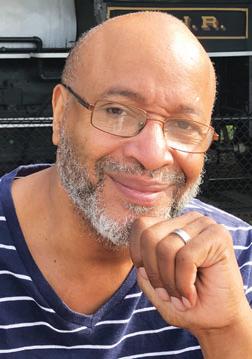
By W.D. Foster-Graham Book Review Editor
WE MISS YOU, GEORGE FLOYD
By Shannon Gibney
Illustrated by Leeya Rose Jackson
Memorial Day, May
25, 2020. For those of us in the Twin Cities area, it was one of those days where we as a community remember where we were and what we were doing, especially with the COVID quarantine going on. The aftermath of that day would be felt around the world. Systemic racism would be laid bare for the world to see in three words: “I can’t breathe.” In a way that will never let us forget, Shannon Gibney’s We Miss You, George Floyd gives us a framework we can share with our children.
Page by page, Gibney and Jackson give us a visual of the day George Floyd was murdered and the events leading up to those final 8 minutes and 46 seconds of his life, through a Black girl’s eyes. Her story includes the people who came from around the county to create his memorial, which is now George Floyd Square, the artwork and the messages, which inspired the main character to leave her own artwork at the memorial.
Gibney doesn’t stop there. She shares the story of his life. In her words, “He was a father, a brother, a son, a hip hop artist, a football and basketball player, and a friend. He was also my neighbor.” In addressing the matter of police brutality, she doesn’t tiptoe around it; rather, she breaks it down for a child’s understanding and discussion. Finally, she reminds us that this fight against injustice is nothing new. It is ongoing, and the victory will not be an easy one, yet there is hope for “a world without police violence.” As African Americans, sooner or later we have to have The Talk with our children when it comes to racism, police brutality/abuse of power, and a world that treats us
as though our lives don’t matter. As an award-winning author, educator, and activist, Gibney gives us a powerful testimony and teaching tool to encourage our children to speak up in the fight for justice and the hope of creating a better world. I give a hat tip to Leeya Rose Jackson for her creative inspiration in helping to bring this story to life. We Miss You, George Floyd is available through Barnes & Noble, Powell’s City of Books, and the University of Minnesota Press. This is a title that bears repeating: we miss you, George Floyd. May we never forget. Thank you, Shannon, for continuing to speak up and speak out.
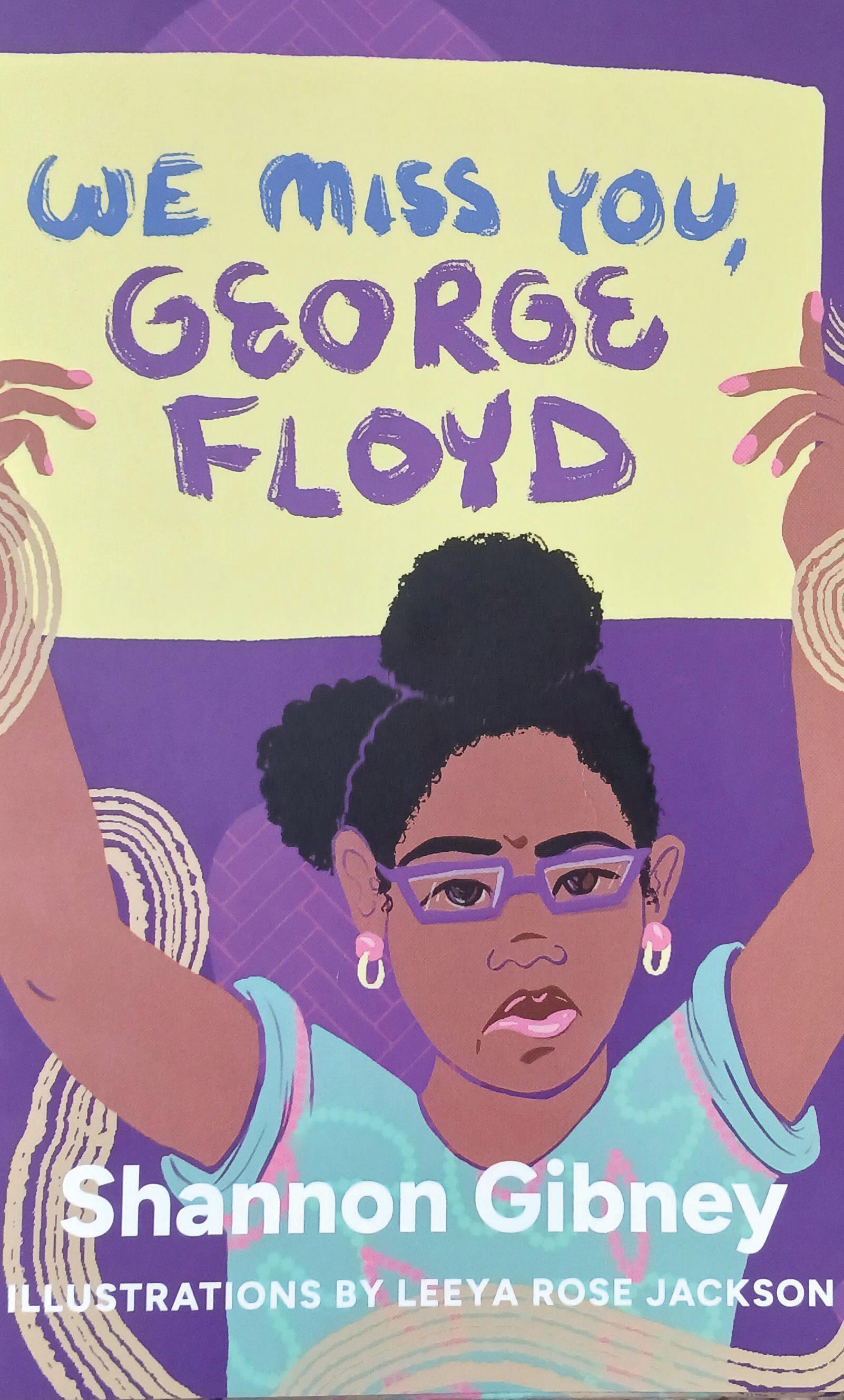
Get Medicare + Medical Assistance (Medicaid) in one plan.
HealthPartners® Minnesota Senior Health Options (MSHO) (HMO SNP)
Enjoy coverage for medical, prescription drugs and dental. Plus, many extra benefits like: Up to $300 annual over-the-counter allowance to buy eligible health, dental and well-being items
Call 877-778-7898 (TTY 711) to find out if you’re eligible. Oct. 1 to March 31: 8 a.m. to 8 p.m. CT, seven days a week; April 1 to Sept. 30: 8 a.m. to 8 p.m. CT, Monday through Friday.


By Andy Steiner MinnPost
A person in the midst of a mental health crisis can feel overwhelmed, frightened and confused. Too often, people in these situations end up in the emergency room — a bright, loud, impersonal space that can only exacerbate their symptoms.
Earlier this summer, The Living Room, a new option for people in mental health crisis, opened at the Emma Norton Residence, a permanent residential housing facility for people who are homeless or at-risk of becoming homeless and managing mental illness and/or chemical dependency, in St. Paul’s Highland Bridge development.
The Emma Norton Living Room, a quiet, welcoming walk-in option with a fireplace, a couch and a few easy chairs, is staffed by a team of specially trained certified peer support specialists. Modeled after similar programs in Illinois, the Emma Norton program is designed to offer a low-barrier option for adults over 18 in need of mental health support, a place they can come and talk to others who have been through similar life situations and learn about options for more immediate or longer-term help.
Lauren Daniel, Emma Norton clinical director, explained that the program’s homey feel is intentional. The driving concept behind Living Room programs is to create a space that will make visitors feel comfortable and at ease — the opposite of a busy hospital ER.
“It’s a really cozy, warm room where you can get that one-on-one individual support in a way that’s nonjudgmental,” Daniel said. Clients come from across the mental health continuum.
“Maybe you’re experiencing your first panic attack and you don’t recognize those symptoms
and you want to talk to someone about it,” she said. “Or maybe it’s folks who are feeling suicidal and they’ve got a plan that they don’t really want to act on so they’re looking for guidance, deescalation and connection to mental health resources.”
Living Room programs are designed to welcome all comers, Daniel added: “Any and all are welcome in the space. That’s the really cool thing about the model.” No insurance or appointments are required, and the program is open seven days a week from 12 p.m.-8 p.m. Startup costs for the Emma Norton Living Room were funded by a $200,000 grant from the Medica Foundation combined with grants from the Minnesota Department of Human Services and Ramsey County. Jacki Yellowflower, Emma Norton peer specialist supervisor, said the program’s low-barrier approach is especially appealing to participants. “It’s really mellow,” Yellowflower said. “People just come in. We have to get certain information from them for our grant purposes, but it’s really simple and fast. Then we just have a conversation.”
Those initial conversations, Yellowflower said, are focused on learning more about the issues that brought the individual to the space. “We just help them figure out what the crisis is. For many people, the word ‘crisis’ is intimidating, like, ‘What I’m feeling, does that constitute a crisis?’” she said. “But it could be pretty much anything that’s bothering them that they want to talk about.”
Living Room staff know how to support people experiencing a range of mental health issues, Yellowflower said. “We have experience with people in active psychosis, the whole spectrum. We’re welcoming,” she said.
Once staff is able to determine the client’s needs,
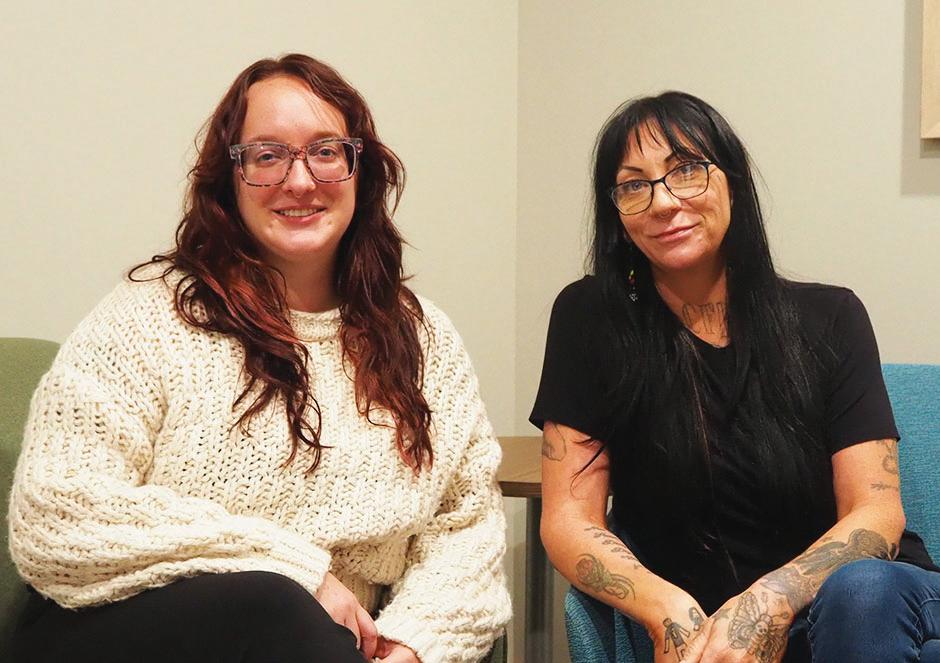
they focus on providing support and connecting them with outside resources. “Basically, our role is deescalation, figuring out what the situation is,” Yellowflower said. “The drop-in thing makes us more accessible, and our hours make us more available than regular clinics. We are the only peer-led dropin crisis center in Minnesota.”
Before opening the Emma Norton Living Room, Daniel, Yellowflower and Shawna Nelsen-Wills, Emma Norton advancement director, drove to suburban Chicago to visit a Living Room Program there. The Chicago Metro Suburban chapter of NAMI has been a major advocate for Living Room programs in Illinois, Nelsen-Wills said. They wanted to learn more about how staffers run the program.
In Illinois, NelsenWills said, organizers “were able to show such success that they went to their state legislature, and now Living Room programs in the state are fully funded 247. We’re hopeful that we’ll be able to show the same kind of success here and eventually get additional public funding here.”
Though Emma Norton’s Living Room program has only been officially open for a few weeks and has not gotten a lot of publicity, it is still getting a steady stream of
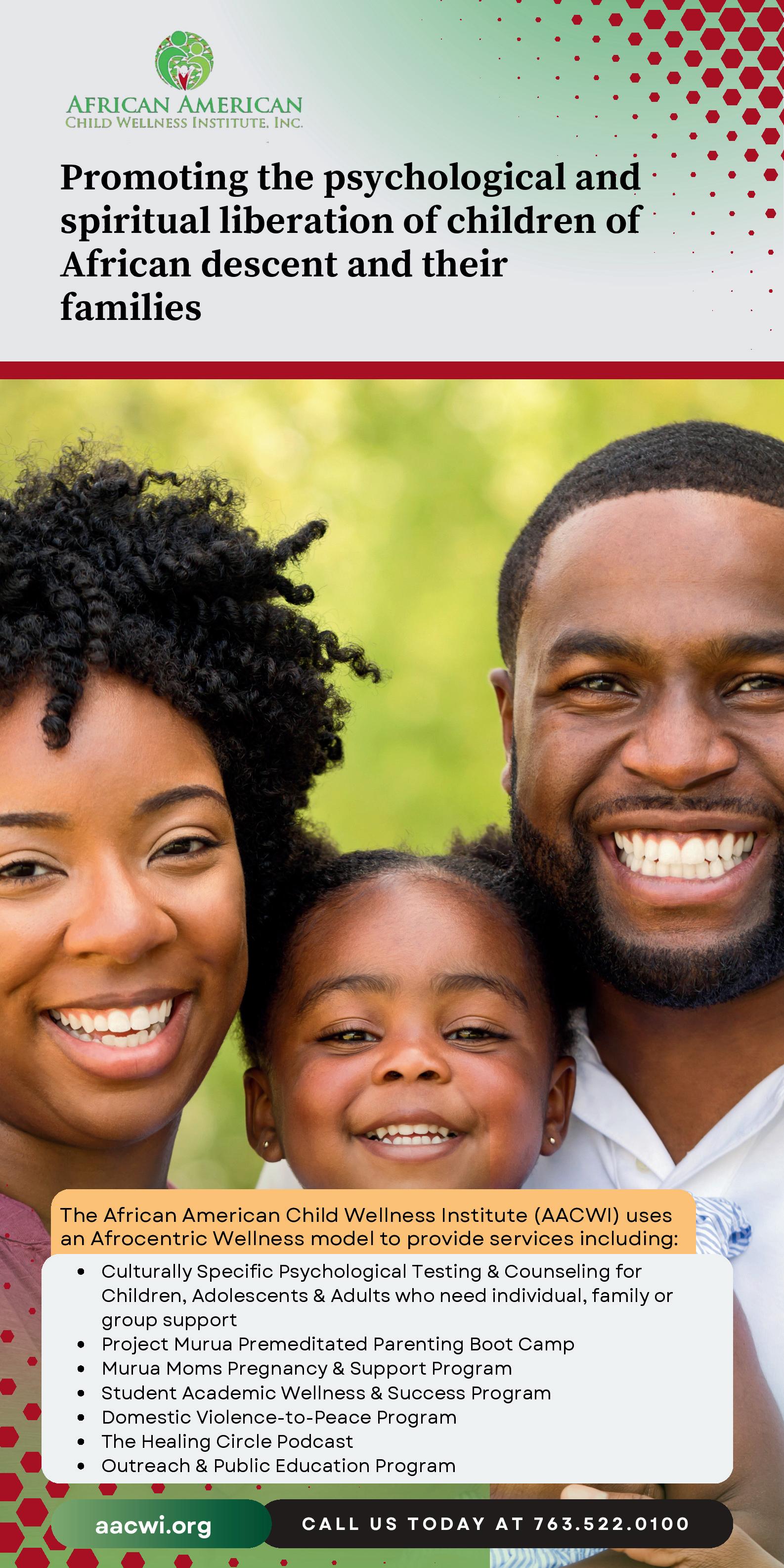
Nelsen-Wills said. Instead, “We wanted to put our money into staff and into our clients and our programs.” Program leaders decided to focus on building a new location that would better serve everyone.
visitors. Since the program’s soft opening in August, NelsenWills said “we’ve had 38 visits so far.”
A safe place for women The Emma Norton Residence was founded in 1917 in St. Paul as a safe place where women coming from rural areas of the state could live in the capital city.
“Back then, women couldn’t come to live in the city unescorted, say if they weren’t married or didn’t have an uncle to stay with,” NelsenWills said. “They couldn’t rent their own apartment.” The residence, originally located near St. Paul’s Summit Avenue and then later moved to Robert Street in downtown St. Paul, was, she said, “a home for girls where you would be able to go to school or work and access opportunities beyond getting married.” The Robert Street building was designed like a dorm, with single rooms with no kitchens. “They served three meals a day,” she said. By the 1970s, more options were available to single women, and fewer needed to live in places like Emma Norton. As the city’s unhoused population grew, Ramsey County eventually asked Emma Norton leaders if the program could become a shelter for women experiencing homelessness. In this new configuration, it didn’t take long for Emma Norton staff to realize that residents needed much more than physical shelter. “We were seeing a lot of mental health or chemical dependency or domestic violence or other issues,” Nelsen-Wills said. In response, she explained, “We quickly became more supportive of housing.” This new approach didn’t work well with the existing building, which had little space beyond resident rooms, shared bathrooms, a kitchen and a dining room, Nelsen-Wills said. There was no office space for the growing number of staff members needed to run the program. And the building, which had been rebuilt in the 1960s, was showing its age.
“We were putting so much money into maintenance,”
A few years ago, Emma Norton leadership teamed with Minneapolisbased nonprofit housing developer Project for Pride in Living to gather funding for a new building. The program ended up in the new Highland Bridge development after PPL was chosen as one of its nonprofit development partners. Eventually, the project was funded through Minnesota Housing’s super RFP process to the tune of $18 million. Because the facility was built new from the ground up, NelsenWills said, Emma Norton leadership had the opportunity to collaborate on its design.
“We knew we wanted everybody to have their own apartment. We knew we wanted to have programming spaces. So each floor has a programming space,” she said. “There’s an art room. There’s a gardening room. There’s a community kitchen. There’s arts spaces. There’s a children’s play space.”
In compliance with fair-housing laws, the program, which still predominantly serves women, now also welcomes men and people of all gender identities. To cover outstanding costs, including furniture and housing supplies for residents, Emma Norton launched its own capital campaign with a goal of raising $3.75 million. “We’ve raised $3.4 million to date,” Nelsen-Wills said. “When people moved in, everyone had a bed and furniture. We didn’t want to take people from homelessness, give them a beautiful apartment and then say they have to sleep on the floor.”
The power of peer support
To many, the most important element of the Living Room model of mental health is the bulk of its services being offered by peer support specialists rather than medical professionals. With their personal history of mental illness and addiction, peers often feel more relatable to people in crisis, and their approach to the work is significantly different than the more distant “professional” approach preferred by credentialed professionals like psychologists and social workers.
“A lot of times when you are meeting with your therapist or a social worker, they are trained to not share personal information,” Daniel said. “But what I love about peer support is that that barrier is not there. It is a job requirement that they share their personal experiences. Anytime our peer support staff share a personal story in a meeting
that I’ve been a part of, it’s just so powerful and it gives a different perspective on things.” Yellowflower said she often shares her personal history in her work with clients. “I’ve been with Emma Norton for about 10 years,” she said. She explained that she lived in the program for two years, then left for a bit before coming back to join the program’s staff. “I experienced the criminal justice system, chaotic family violence, drug addiction, alcohol addiction and things like that,” she said. “And it’s not just me; a lot of our peer supports have personal experience in a variety of different areas. That makes us a little bit more relatable.” Daniel said that she understands why many Living Room clients prefer to speak with a peer. “I’ve noticed clients have a hesitancy in meeting with me because I’ve got letters behind my name. There’s a stigma that comes with being a social worker — especially when folks have trauma histories that involve the criminal justice system. It makes it harder to open up,” she said. Yellowflower understands that hesitancy all too well. “It does make it harder to relate to a provider because that’s your experience,” she said. “If you’re labeled an addict, you’re pre-judged. It makes you not want to open up.”
In recognition of that fact, peers run The Living Room program, Nelsen-Wills said, with professionally credentialed mental health staff like Daniel on duty to for backup if a client needs to be transferred to a hospital. So far, Daniel said, her assistance hasn’t been needed. The peer support staff have things under control. “We’ve been open since Aug. 5 and I’ve gotten one on-call phone call so far,” she said. “I can’t speak highly enough of how proud I am of our peer support team and the hard work that they’ve been putting in.” At the Emma Norton Residence Living Room program, two peer support specialists are always on duty. So far, that has been enough to meet client needs, but if the program begins to attract more people, NelsenWills said they will staff up. “If we start to have a bunch of people waiting to talk to someone,” she said, “that is an opportunity for me to say we’ve got this issue and we need more funding so we can bring more people on.”
Andy Steiner Andy Steiner is a Twin Cities-based writer and editor. Before becoming a fulltime freelancer, she worked as senior editor at Utne Reader and editor of the Minnesota Women’s Press. Email her at asteiner@minnpost.com.
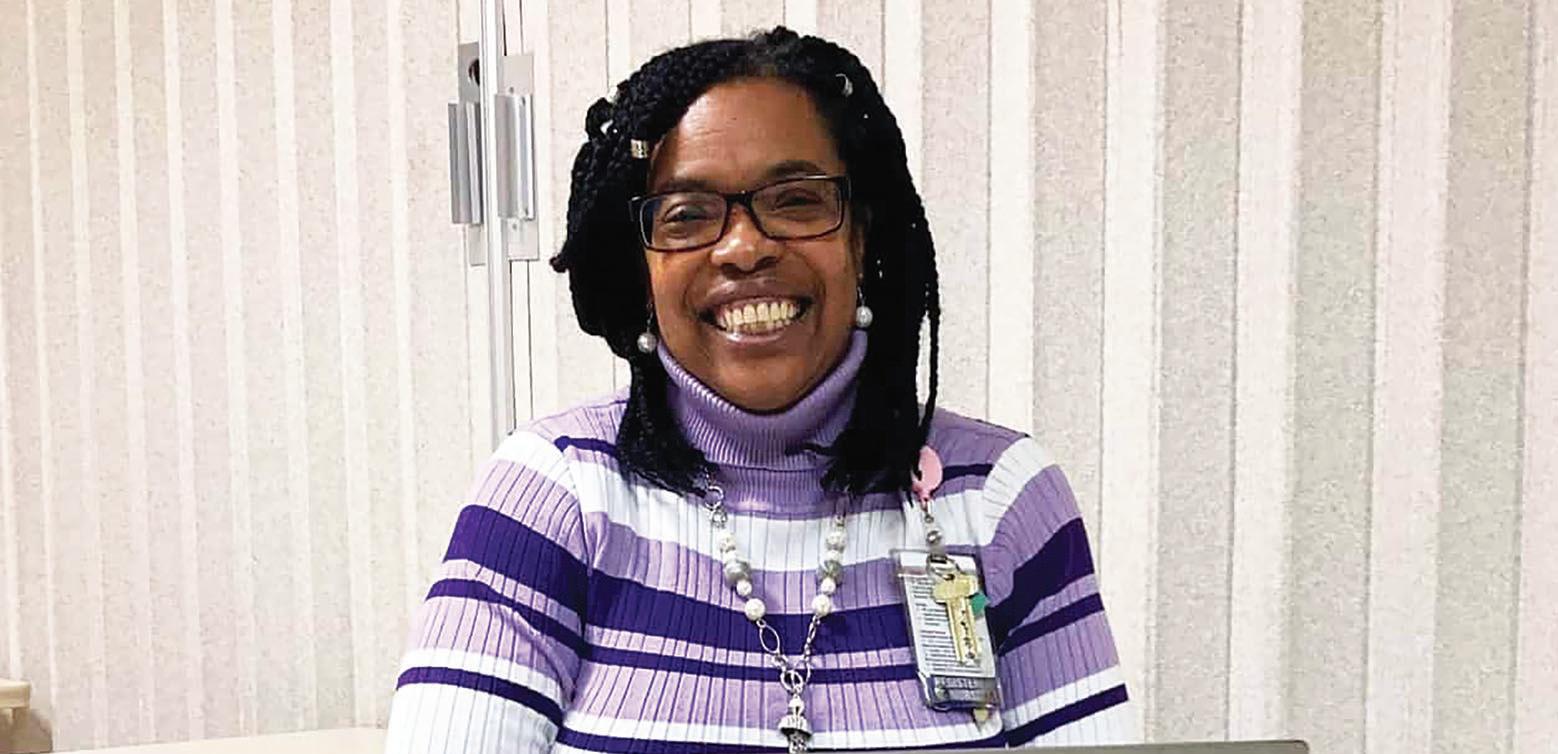
“My great-grandmother, Flossie Washington, is the one who inspired me to care for everyone in the community. She cared for the homeless and anyone struggling with addictions in New York City, where I’m originally from. When I became a nurse, I knew I wanted
By Terryann Nash,
Hopkins High School is proud to announce the second year of its groundbreaking American Sign Language (ASL) program, which is setting new standards in language education. This premier initiative utilizes a unique team-teaching approach, featuring both a Deaf and a nonDeaf educator, both of whom are African American. This dynamic partnership exemplifies the school’s commitment to inclusivity and representation in language education.
Adding to the school’s commitment to diversity, Hopkins High School is currently led by Black Principal Crystal Ballard, who champions innovative programs that foster an inclusive learning environment.
The ASL curriculum not only teaches students the fundamentals of sign language but also immerses them in Deaf culture and its profound impact on the world. Through this program, students embark on a
journey of human development that opens doors to greater opportunities, fostering a deeper understanding of communication and community. This week, the program will host a workshop with Dr. Regina Daniels, a distinguished Deaf interpreter and college professor at North Central College in Minneapolis. Dr. Daniels is one of only 55 Black Deaf individuals in the U.S. with a PhD, out of an estimated 11 million ASL users. Her remarkable credentials include interpreting at the National Presidential Debates, making her visit to Hopkins High School



















